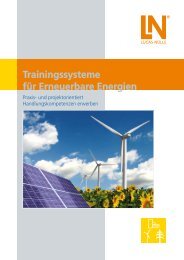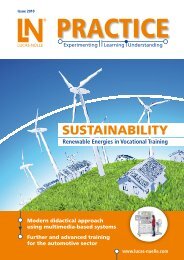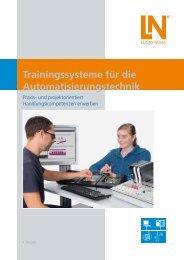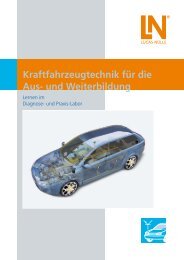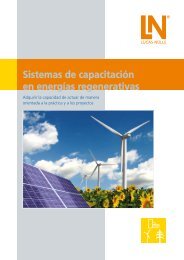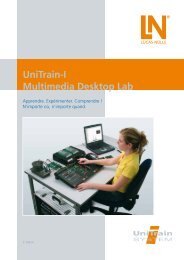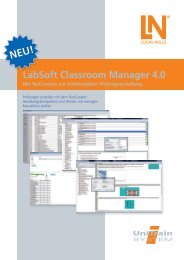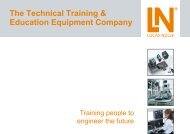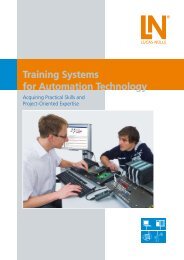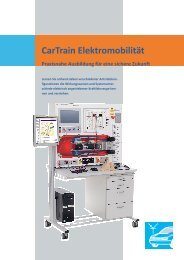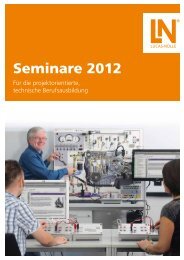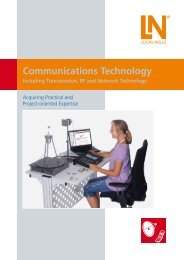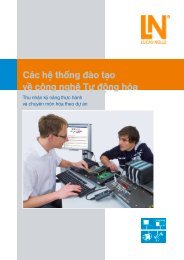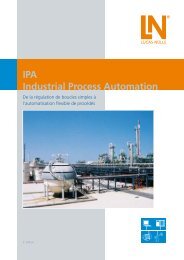Training and Further Education in Automotive ... - Lucas-Nülle
Training and Further Education in Automotive ... - Lucas-Nülle
Training and Further Education in Automotive ... - Lucas-Nülle
Create successful ePaper yourself
Turn your PDF publications into a flip-book with our unique Google optimized e-Paper software.
... us<strong>in</strong>g premium tra<strong>in</strong><strong>in</strong>g systems.To be able to impart this <strong>in</strong> a susta<strong>in</strong>ed fashion tra<strong>in</strong><strong>in</strong>g systemsare needed which are not only state of the art technically but alsodidactically conceived to comply with the requirements prevalent<strong>in</strong> the workplace. Practical exercises <strong>and</strong> well-grounded theoreticalbackground <strong>in</strong>formation form the foundation for one of the keycompetences: excellent h<strong>and</strong>s-on skills. These skills are alreadydeveloped by the tra<strong>in</strong>ee dur<strong>in</strong>g the tra<strong>in</strong><strong>in</strong>g period <strong>in</strong> conjunctionwith the <strong>Lucas</strong>-<strong>Nülle</strong> tra<strong>in</strong><strong>in</strong>g systems. In the course of work<strong>in</strong>gon projects <strong>and</strong> dur<strong>in</strong>g self-monitored learn<strong>in</strong>g processes, youngpeople discover the fasc<strong>in</strong>ation of automotive technology while atthe same time atta<strong>in</strong><strong>in</strong>g a high degree of work satisfaction. This isbecause <strong>in</strong>dividual learn<strong>in</strong>g <strong>and</strong> positive feedback are part of thedidactic concept.Cover<strong>in</strong>g everyth<strong>in</strong>g from the basics tof<strong>in</strong>al graduation“The tra<strong>in</strong><strong>in</strong>g systems from <strong>Lucas</strong>-<strong>Nülle</strong> cover every aspect oftra<strong>in</strong><strong>in</strong>g <strong>in</strong> automotive technology. Whether the subject is thebasics of automotive electricity, light<strong>in</strong>g <strong>and</strong> comfort systemsor motor vehicle diagnostics, LN has the correspond<strong>in</strong>g systemfor every subject <strong>and</strong> situation.All of the tra<strong>in</strong><strong>in</strong>g subjects are thoroughly covered <strong>in</strong> the<strong>Automotive</strong> Diagnostics Workshop Lab.Us<strong>in</strong>g modular <strong>and</strong> scalable learn<strong>in</strong>g <strong>and</strong> tra<strong>in</strong><strong>in</strong>g systemsthe foundation is laid for an endur<strong>in</strong>g, cont<strong>in</strong>uously updatedtra<strong>in</strong><strong>in</strong>g <strong>and</strong> educational program at the workplace, <strong>in</strong>vocational schools <strong>and</strong> <strong>in</strong>dustry-wide tra<strong>in</strong><strong>in</strong>g.”Siegfried SchulzProduct Manager <strong>Automotive</strong> Eng<strong>in</strong>eer<strong>in</strong>gMartijn V<strong>in</strong>ckenProduct Manager <strong>Automotive</strong> Eng<strong>in</strong>eer<strong>in</strong>g5
More Than a LaboratoryComplete Solution – Diagnostics Workshop Labfor <strong>Automotive</strong> Eng<strong>in</strong>eer<strong>in</strong>gLucid presentations of complex concepts withmodern tra<strong>in</strong><strong>in</strong>g <strong>and</strong> educational mediaComplete solutions for modern eng<strong>in</strong>emanagement, brake, climate control <strong>and</strong>airbag systems<strong>Tra<strong>in</strong><strong>in</strong>g</strong> Panel SystemsIndividual experiment set-ups for competent systemunderst<strong>and</strong><strong>in</strong>gCarTra<strong>in</strong><strong>Tra<strong>in</strong><strong>in</strong>g</strong> on real components – <strong>in</strong>teractive course software isused to facilitate overall system comprehension6<strong>Lucas</strong>-<strong>Nülle</strong>
Student Measurement StationsMultisignal-capable environment provided for each studentas a guarantee for optimum learn<strong>in</strong>g success<strong>Tra<strong>in</strong><strong>in</strong>g</strong> VehicleDiagnostics performed directly on the motor vehicle –test<strong>in</strong>g <strong>and</strong> ma<strong>in</strong>ta<strong>in</strong><strong>in</strong>g networked systemsUniTra<strong>in</strong>-IDeepen<strong>in</strong>g the student’s underst<strong>and</strong><strong>in</strong>g us<strong>in</strong>gthe hardware <strong>and</strong> software provided with theexperiments<strong>Lucas</strong>-<strong>Nülle</strong>7
System OverviewNeeds-oriented <strong>Tra<strong>in</strong><strong>in</strong>g</strong> SystemsUniTra<strong>in</strong>-I – a Multimedia Laboratory with over 100 CoursesWith the UniTra<strong>in</strong>-I multimedia experiment <strong>and</strong> tra<strong>in</strong><strong>in</strong>g system,students are guided through the experiments by means of clearlystructured course software <strong>in</strong>clud<strong>in</strong>g texts, graphics, animations<strong>and</strong> knowledge tests. In addition to the tra<strong>in</strong><strong>in</strong>g software,each course comes with an experiment card for perform<strong>in</strong>gpractical exercises. Courses such as those on the fundamentalsof electrical eng<strong>in</strong>eer<strong>in</strong>g, automotive sensors <strong>and</strong> ignitionsystems convey the knowledge <strong>and</strong> skills needed to underst<strong>and</strong>,connect, diagnose <strong>and</strong> operate modern automotive systems.Animations <strong>and</strong> numerous experiments on authentic systemsfound <strong>in</strong> the various courses impart the fundamentals, pr<strong>in</strong>ciples<strong>and</strong> attributes of electrical, safety, light<strong>in</strong>g <strong>and</strong> eng<strong>in</strong>e-managementequipment.Your benefits• Theory <strong>and</strong> practice all <strong>in</strong> one• PC <strong>and</strong> new media for high levels of student motivation• Quick success through structured course design• Animated theory for quick underst<strong>and</strong><strong>in</strong>g• Practical competence through <strong>in</strong>dependent experimentation• Guided trouble shoot<strong>in</strong>g with an <strong>in</strong>tegrated fault simulator• Protective, extra-low voltages ensure safe operation• Sample solutions for teachers <strong>and</strong> students8<strong>Lucas</strong>-<strong>Nülle</strong>
KraftfahrzeugtechnikUniTra<strong>in</strong>-I system• Comprehensive, portable laboratory• Multimedia-based courses• High-tech measurement <strong>and</strong> control <strong>in</strong>terface• Tra<strong>in</strong>s theory <strong>and</strong> practice at same time <strong>and</strong> locationIntegrated meters <strong>and</strong> power supply units• Multimeter, ammeter, voltmeter• 2-channel storage oscilloscope• Function <strong>and</strong> signal generator• Three-fold power supply unit for AC <strong>and</strong> DC• Three-phase power supply unit• … <strong>and</strong> many more <strong>in</strong>strumentsLabSoft learn<strong>in</strong>g <strong>and</strong> experiment<strong>in</strong>g software• Wide selection of courses• Comprehensive background theory• Animations• Interactive experiments with <strong>in</strong>struction guide• Free navigation• Documentation of measurement results• Tests available <strong>in</strong> the language of your choiceUniTra<strong>in</strong>-I <strong>in</strong>terface with USB• Oscilloscope with 2 analoguedifferential <strong>in</strong>puts• Sampl<strong>in</strong>g rate of 40Msamples/s• 9 measur<strong>in</strong>g ranges from100 mV - 50 V• 22 time ranges from1 µs - 10 s• 16 digital <strong>in</strong>puts/ outputs• Function generator forfrequencies up to 1 MHz• 8 relays for fault simulationUniTra<strong>in</strong>-I experimenter• Holds experiment cards• Experiment power supply of± 15 V, 400 mA• Experiment power supply of5 V, 1 A• Variable direct or threephasecurrent, 0 - 20 V, 1 A• IrDa <strong>in</strong>terface for multimeters• Serial <strong>in</strong>terface for additionalexperiment cards<strong>Lucas</strong>-<strong>Nülle</strong>9
System OverviewNeeds-oriented <strong>Tra<strong>in</strong><strong>in</strong>g</strong> SystemsEloTra<strong>in</strong> Courses: 2mm Plug-In SystemTogether with the multimedia experimentation <strong>and</strong> tra<strong>in</strong><strong>in</strong>g system,the EloTra<strong>in</strong> 2-mm plug-<strong>in</strong> system provides a modern <strong>and</strong>efficient environment for sound tra<strong>in</strong><strong>in</strong>g <strong>in</strong> the fundamentals ofelectrical eng<strong>in</strong>eer<strong>in</strong>g <strong>and</strong> electronics.Students are guided through the experiments by means ofclearly structured course software <strong>in</strong>clud<strong>in</strong>g texts, graphics,animations <strong>and</strong> knowledge tests. The experiments are tailoredespecially to automotive applications to facilitate an underst<strong>and</strong><strong>in</strong>gof this complex subject <strong>and</strong> are conducted on a 2-mm experimenterdeveloped specially for the UniTra<strong>in</strong>-I. A wide rangeof virtual <strong>in</strong>struments are available for real-time measurementsby students.Multimedia course with measure <strong>in</strong>terfaceYour benefits• Modern educational media comb<strong>in</strong>ed with a proven system of plug-<strong>in</strong> modules• Virtual <strong>in</strong>struments for real-time measurements of current, voltage <strong>and</strong> resistance; no need for external power supplies ormeasur<strong>in</strong>g <strong>in</strong>struments• High student motivation through new, PC-based media• Quick success through structured courses• Practical competence through <strong>in</strong>dependent experimentation• Regular feedback through quizzes <strong>and</strong> knowledge tests• Safe h<strong>and</strong>l<strong>in</strong>g thanks to protective, extra-low voltages10<strong>Lucas</strong>-<strong>Nülle</strong>
KraftfahrzeugtechnikEloTra<strong>in</strong> Courses: 4mm Plug-In SystemThe EloTra<strong>in</strong> 4-mm plug-<strong>in</strong> system is an extensive kit for experimentation<strong>in</strong> the field of electrical eng<strong>in</strong>eer<strong>in</strong>g, electronics <strong>and</strong>digital technology. By <strong>in</strong>stall<strong>in</strong>g 4-mm plug-<strong>in</strong> modules on anEloTra<strong>in</strong> experimenter, electronic circuits of any required sizecan be assembled, operated <strong>and</strong> tested. Students are guidedthrough the experiments by means of clearly organized experimentation<strong>in</strong>structions; the knowledge acquired <strong>in</strong> this process isconsolidated <strong>in</strong> numerous tests.This set is especially tailored to the needs of students <strong>in</strong> thefield of automotive <strong>and</strong> allows a vast range of experimentson the fundamentals of automotive electrical eng<strong>in</strong>eer<strong>in</strong>g <strong>and</strong>electronics. The set comes on an A4 storage plate with scratchresistant,colour pr<strong>in</strong>t.<strong>Tra<strong>in</strong><strong>in</strong>g</strong> course with comprehensive manualsYour benefits• Gold-plated contacts• Extremely practical approach• Students’ exercises tailored specially to automotive eng<strong>in</strong>eer<strong>in</strong>g• 1:1 mapp<strong>in</strong>g of circuit diagrams on the rastered plug-<strong>in</strong> board• Explor<strong>in</strong>g complex relationships through experimentation• Universal applications• Robust components• High degree of transparency<strong>Lucas</strong>-<strong>Nülle</strong>11
System OverviewNeeds-oriented <strong>Tra<strong>in</strong><strong>in</strong>g</strong> Systems<strong>Tra<strong>in</strong><strong>in</strong>g</strong> on Real Components: CarTra<strong>in</strong>CarTra<strong>in</strong> comb<strong>in</strong>es multimedial teach<strong>in</strong>g material with real motorvehicle components. System complexity is made far more accessible<strong>and</strong> hence underst<strong>and</strong>able to the student us<strong>in</strong>g didacticallymodified graphic <strong>in</strong>terface design comb<strong>in</strong>ed with optimized componentconfiguration.Your benefits• Practice-oriented tra<strong>in</strong><strong>in</strong>g us<strong>in</strong>g orig<strong>in</strong>al components• Fault simulation with up to 50 different faults• Real <strong>and</strong> simulation mode• OBD readout function us<strong>in</strong>g CAN-Bus <strong>in</strong>terface• Integrated <strong>in</strong>strumentation• Freely-programmable control unit• Measurements us<strong>in</strong>g workshop tester• Interactive learn<strong>in</strong>g software• 3-D animations of <strong>in</strong>dividual components• Tests <strong>and</strong> system comprehension questions12<strong>Lucas</strong>-<strong>Nülle</strong>
KraftfahrzeugtechnikSimulation <strong>and</strong>/or real mode assists <strong>in</strong> solidify<strong>in</strong>g knowledge<strong>and</strong> underst<strong>and</strong><strong>in</strong>g for the overall system. Switchover can becarried out dur<strong>in</strong>g operation.Us<strong>in</strong>g the OBD II term<strong>in</strong>al you can connect any OBD II-capablediagnostics tester <strong>and</strong> read out important data needed for troubleshoot<strong>in</strong>g.Deploys expert systems, determ<strong>in</strong>es data <strong>and</strong> updates it us<strong>in</strong>gcontrol unit software, perform resets to default sett<strong>in</strong>gs onmotor vehicle systems.Didactically designed <strong>in</strong>teractive tra<strong>in</strong><strong>in</strong>g software showshow to design <strong>and</strong> operate sensors, actuators <strong>and</strong> subsystems ofthe direct fuel <strong>in</strong>jection system MED with turbo charger.<strong>Lucas</strong>-<strong>Nülle</strong>13
Multimedia Learn<strong>in</strong>g EnvironmentLabSoft as System-based <strong>Tra<strong>in</strong><strong>in</strong>g</strong>/Adm<strong>in</strong>istration SoftwareLabSoftLabSoft is the user <strong>in</strong>terface for all automotive courses <strong>and</strong> constitutesan open experimentation platform that permits access toall laboratory media:• Navigation w<strong>in</strong>dow with tree structure for display <strong>and</strong> directselection of all course components• Experiment procedure <strong>in</strong>clud<strong>in</strong>g documentation• Evaluation <strong>and</strong> storage of the measurement results• Built-<strong>in</strong> fault simulator• Virtual <strong>in</strong>struments perform real-time measurements- Voltmeter, ammeter- Storage oscilloscope- Function generatorsLabSoft Classroom ManagerThe LabSoft Classroom Manager is comprehensive adm<strong>in</strong>istrationsoftware for all LabSoft courses. The Classroom Managerconsists of various program elements:LabSoft Reporter:Monitor learn<strong>in</strong>g progress <strong>and</strong> generate statisticsLabSoft Editor:Create <strong>and</strong> edit your own courses <strong>and</strong> testsLabSoft Manager:Manage user data <strong>and</strong> courses <strong>in</strong> LabSoftLabSoft TestCreator:Create test problems <strong>and</strong> exams14<strong>Lucas</strong>-<strong>Nülle</strong>
KraftfahrzeugtechnikLabSoft <strong>in</strong> the NetworkLabSoft supports both local <strong>in</strong>stallation on the user’s computeras well as <strong>in</strong>stallation on a central server that permits accessvia <strong>in</strong>tranet or <strong>in</strong>ternet. To facilitate <strong>in</strong>tegration <strong>in</strong>to Learn<strong>in</strong>gManagement Systems the developers of LabSoft <strong>in</strong>corporated<strong>in</strong>ternational st<strong>and</strong>ards.UniTra<strong>in</strong>-ILabSoftCarTra<strong>in</strong>Panel SystemManualsIn addition to <strong>in</strong>-depth descriptions the manuals covereveryth<strong>in</strong>g from commission<strong>in</strong>g the respective tra<strong>in</strong><strong>in</strong>g systemto project examples <strong>and</strong> also <strong>in</strong>clude numerous exercises <strong>and</strong>experiments.<strong>Lucas</strong>-<strong>Nülle</strong>15
The Entire Program at a GlanceSolutions for Vocational <strong>Tra<strong>in</strong><strong>in</strong>g</strong> <strong>and</strong> <strong>Education</strong> <strong>in</strong> <strong>Automotive</strong> Eng<strong>in</strong>eer<strong>in</strong>gElectricity/ElectronicsUniTra<strong>in</strong>-IBasics of Electrical Eng<strong>in</strong>eer<strong>in</strong>g ........................................... 22Basics of Electronics <strong>and</strong> Digital Technology........................ 23Three-phase Generator....................................................... 24Pulse-width Modulated Signals........................................... 25Panel SystemGenerator with Multifunction Controller ............................ 26Generator with Hybrid Controller ....................................... 27Alternative DrivesCarTra<strong>in</strong>Electromobility ................................................................... 56UniTra<strong>in</strong>-IHybrid Drive <strong>in</strong> Motor Vehicles ........................................... 58DC/AC Conversion ............................................................. 59Fuel Cells ........................................................................... 60Photovoltaics ..................................................................... 61Sensors <strong>and</strong> ActuatorsUniTra<strong>in</strong>-ISensors <strong>and</strong> Actuators <strong>in</strong> the Motor Vehicle ....................... 32Compact SystemSensor Technology <strong>in</strong> Eng<strong>in</strong>e Management ........................ 33Motor Vehicle Light<strong>in</strong>gPanel SystemMa<strong>in</strong> Lights ........................................................................ 39Auxiliary Lights ................................................................... 40Trailer Lights....................................................................... 41Static Corner<strong>in</strong>g Light ........................................................ 42CAN-Bus Extension ............................................................ 42Onboard Power Supply Expansion ...................................... 43Chassis <strong>and</strong> Driv<strong>in</strong>g SafetyComfort SystemsPanel SystemAlarm System ..................................................................... 48Compact SystemGPS Navigation .................................................................. 48Air-condition<strong>in</strong>g System ..................................................... 49UniTra<strong>in</strong>-IAuto Repair Shop Communication ..................................... 50Comfort Systems ............................................................... 51Compact SystemElectromechanical Park<strong>in</strong>g Brake ........................................ 96Electromechanical Power Steer<strong>in</strong>g ...................................... 97SRS Airbag ......................................................................... 99ABS <strong>and</strong> ASR ................................................................... 101UniTra<strong>in</strong>-IAirbag ............................................................................... 98ABS/ASR <strong>and</strong> ESP ............................................................. 10016<strong>Lucas</strong>-<strong>Nülle</strong>
Networked SystemsUniTra<strong>in</strong>-ICAN Bus .......................................................................... 106LIN Bus ............................................................................ 108Fibre Optic Waveguides .................................................... 109FlexRay ............................................................................ 110Panel SystemCAN Light<strong>in</strong>g Technology ................................................. 107CAN Comfort Technology ................................................ 107Practical <strong>Tra<strong>in</strong><strong>in</strong>g</strong> LabCompact SystemExhaust Gas Analysis <strong>and</strong> EOBD Data Readout ................ 112Tire-Fitt<strong>in</strong>g Mach<strong>in</strong>e ........................................................ 112Balanc<strong>in</strong>g Mach<strong>in</strong>e .......................................................... 113Axle Measurement .......................................................... 113Hydraulic Lift<strong>in</strong>g Platform ................................................ 114Air-condition<strong>in</strong>g Service Unit ........................................... 115Motor Vehicle Tool Trolley ............................................... 115Compact SystemDashboard <strong>Tra<strong>in</strong><strong>in</strong>g</strong> Model/St<strong>and</strong> ..................................... 111Eng<strong>in</strong>e ManagementCarTra<strong>in</strong>Motronic 2.8 ...................................................................... 68Direct Fuel Injection ........................................................... 70Common Rail ..................................................................... 72UniTra<strong>in</strong>-IIgnition Systems ................................................................. 78Common Rail ..................................................................... 79Compact SystemCommon Rail ..................................................................... 80Electronic Diesel Control .................................................... 81Student/Teacher Measurement Stations .............................. 74Functional Eng<strong>in</strong>e <strong>and</strong> Cutaway Model .............................. 76Chip Tun<strong>in</strong>g ....................................................................... 82Auto-Diagnosis Tra<strong>in</strong>er Software ........................................ 83Motor Vehicle DiagnosticsPanel SystemOBD-II ............................................................................... 88Diagnostics EquipmentCAN/LIN Monitor .............................................................. 89High-voltage <strong>in</strong>strumentation ............................................ 89Snap-on MODIS ................................................................ 90Snap-on SOLUS PRO ......................................................... 91Snap-on VERUS ................................................................. 91<strong>Lucas</strong>-<strong>Nülle</strong>17
Electricity/ElectronicsDC <strong>and</strong> AC Technology <strong>in</strong> the Motor Vehicle............................. 22Electronics <strong>and</strong> Digital Technology <strong>in</strong> the Motor Vehicle............ 23Three-phase Alternator/Generator............................................. 24Pulse-width Modulated Signals (PWM)...................................... 25Three-phase Generator with Multifunction Controller............... 26Three-phase Generator with Hybrid Controller.......................... 27
KraftfahrzeugtechnikElectricity/ElectronicsElectricity/ElectronicsBasic Practice-oriented Know-howFor years now electrical <strong>and</strong> electronic applications have beenplay<strong>in</strong>g an ever more important role <strong>in</strong> the motor vehicle. Forthat reason it is essential for tra<strong>in</strong>ees to become familiar withthe most important fundamentals of automotive electricaleng<strong>in</strong>eer<strong>in</strong>g from the outset. This is the prerequisite tounderst<strong>and</strong><strong>in</strong>g the complex <strong>in</strong>teractions tak<strong>in</strong>g place <strong>in</strong> thevehicle. It is no accident that 80 tra<strong>in</strong><strong>in</strong>g hours are planned forthis topic <strong>in</strong> the <strong>in</strong>itial tra<strong>in</strong><strong>in</strong>g year. Our tra<strong>in</strong><strong>in</strong>g systems forelectronics <strong>and</strong> electrical eng<strong>in</strong>eer<strong>in</strong>g have been f<strong>in</strong>e-tunedspecifically for everyday applications found on the job.Supported by a host of examples, explanations, lessons <strong>and</strong>practical exercises, the tra<strong>in</strong>ee acquires the backgroundknow-how <strong>and</strong> develops the necessary skills.20
KraftfahrzeugtechnikElectricity/ElectronicsAnalogue TechnologyDigital TechnologyIn electrical eng<strong>in</strong>eer<strong>in</strong>g, an analogue system is one where physicalquantities cont<strong>in</strong>uously vary <strong>in</strong> value <strong>and</strong> time. The LN casesystem imparts the related fundamentals <strong>in</strong> a practical manner.This topic deals with the process<strong>in</strong>g of discrete-value <strong>and</strong>discrete-time numerical sequences as well as digital signals.Our basic courses are made up of typical automotive examples<strong>and</strong> exercises <strong>in</strong>tended to provide the most practical tra<strong>in</strong><strong>in</strong>gpossible.<strong>Tra<strong>in</strong><strong>in</strong>g</strong> SystemsOur tra<strong>in</strong><strong>in</strong>g systems cover the most important topics. Students<strong>and</strong> tra<strong>in</strong>ees acquire the basics of electrical eng<strong>in</strong>eer<strong>in</strong>g <strong>and</strong>electronics, become familiar with semiconductor components<strong>and</strong> learn about basic <strong>and</strong> applied electronic circuits <strong>and</strong> basic<strong>and</strong> applied digital circuits.<strong>Lucas</strong>-<strong>Nülle</strong>21
Electricity/ElectronicsElectricity/ElectronicsDC <strong>and</strong> AC Technology <strong>in</strong> the Motor VehicleThe grow<strong>in</strong>g importance of electrical <strong>and</strong> electronic components<strong>in</strong> the motor vehicle makes the h<strong>and</strong>s-on tra<strong>in</strong><strong>in</strong>gapproach to basic electronic circuits an absolute necessity. OurUniTra<strong>in</strong>-I course on DC <strong>and</strong> AC technology <strong>in</strong> the vehicle enablestudents to acquire this know-how through <strong>in</strong>dependent selflearn<strong>in</strong>g.They come to grips with such terms as current, voltage<strong>and</strong> resistance, tra<strong>in</strong> <strong>in</strong> how to operate measur<strong>in</strong>g <strong>in</strong>struments<strong>and</strong> conduct experiments us<strong>in</strong>g Ohm’s <strong>and</strong> Kirchhoff’s laws. Allof the required measur<strong>in</strong>g <strong>in</strong>struments are already built <strong>in</strong>to theUniTra<strong>in</strong>-I’s multimedia tra<strong>in</strong><strong>in</strong>g environment.Conduct<strong>in</strong>g Measurementswith the Computer<strong>Tra<strong>in</strong><strong>in</strong>g</strong> contents• Basic concepts of current, voltage <strong>and</strong> resistance• H<strong>and</strong>l<strong>in</strong>g power sources <strong>and</strong> measur<strong>in</strong>g <strong>in</strong>struments• Usage of circuit diagrams for the analysis of electrical components• Putt<strong>in</strong>g to use accident prevention regulations perta<strong>in</strong><strong>in</strong>g to work with electrical current• Measurements on series <strong>and</strong> parallel circuits, voltage dividers <strong>and</strong> mixed circuits• Evaluation of measurement f<strong>in</strong>d<strong>in</strong>gs us<strong>in</strong>g comparative tables• Record<strong>in</strong>g characteristics of variable resistors (LDR, NTC, PTC, VDR)• Trouble shoot<strong>in</strong>g22 UniTra<strong>in</strong>-I course SO4204-7A<strong>Lucas</strong>-<strong>Nülle</strong>
Electricity/ElectronicsElectricity/ElectronicsThree-phase Alternator/GeneratorVirtually all modern motor vehicles are equipped with a threephasegenerator to produce the required electrical energy.With the UniTra<strong>in</strong>-I course the tra<strong>in</strong>ees ga<strong>in</strong> <strong>in</strong>sight <strong>in</strong>to thegenerator’s basic functions <strong>and</strong> learn how to control it. They alsoplan <strong>and</strong> carry out diagnostics, ma<strong>in</strong>tenance <strong>and</strong> repair work onthe power supply <strong>and</strong> the start<strong>in</strong>g systems.<strong>Tra<strong>in</strong><strong>in</strong>g</strong> contents• Generator pr<strong>in</strong>ciple• Basics of three-phase current• Diode <strong>and</strong> rectifier circuits• Functionality of an unregulated three-phase alternator/generator• Discrete <strong>and</strong> <strong>in</strong>tegrated voltage controllers• Regulated three-phase alternator/generator• Fault diagnosis• Compliance with accident prevention regulations24 UniTra<strong>in</strong>-I course SO4204-7D<strong>Lucas</strong>-<strong>Nülle</strong>
Electricity/ElectronicsPulse-width Modulated Signals (PWM)Many actuator systems <strong>in</strong> motor vehicles require variable powerlevels for the devices be<strong>in</strong>g controlled. Actuators which need toassume <strong>in</strong>termediate values between the ON <strong>and</strong> OFF limits arecontrolled by means of pulse-width modulated signals. With ourtra<strong>in</strong><strong>in</strong>g system tra<strong>in</strong>ees document their measurement results,signals <strong>and</strong> fault protocols <strong>and</strong> analyse, evaluate <strong>and</strong> presenttheir f<strong>in</strong>d<strong>in</strong>gs. This way they are able to isolate faults <strong>and</strong>propose suitable strategies for fault rectification.<strong>Tra<strong>in</strong><strong>in</strong>g</strong> contents• Pr<strong>in</strong>ciple of PWM• <strong>Automotive</strong> PWM applications• Adjust<strong>in</strong>g the power of electrical loads with PWM• Measur<strong>in</strong>g a PWM signal’s characteristics: frequency, amplitude, mark-to-space ratio• Pulse width, edges <strong>and</strong> signal shapes• Control <strong>and</strong> operat<strong>in</strong>g-current circuits• Diagnosis of PWM-controlled componentsUniTra<strong>in</strong>-I course SO4204-7J<strong>Lucas</strong>-<strong>Nülle</strong>25
Electricity/ElectronicsElectricity/ElectronicsThree-phase Generator with Multifunction ControllerThis tra<strong>in</strong><strong>in</strong>g system is used to exam<strong>in</strong>e how energy is generated<strong>in</strong> modern motor vehicles. Today‘s compact generators makeuse of a monolithic controller. This k<strong>in</strong>d of multifunction controller(MFC) has now largely replaced hybrid controllers. A progressivesequence of experiments gradually <strong>in</strong>troduces students tothe subject of power generation <strong>in</strong> automobiles.<strong>Tra<strong>in</strong><strong>in</strong>g</strong> contents• Workshop orders <strong>and</strong> descriptions of faults form the basis of students’ plans for test<strong>in</strong>g <strong>and</strong>repair<strong>in</strong>g automotive electrical <strong>and</strong> electronic systems• Pr<strong>in</strong>ciple of three-phase generation <strong>and</strong> voltage regulation• Underst<strong>and</strong><strong>in</strong>g how a three-phase alternat<strong>in</strong>g voltage arises• Properties of a multifunction controller• Underst<strong>and</strong><strong>in</strong>g rectification <strong>and</strong> protection us<strong>in</strong>g power Z-diodes• Battery monitor<strong>in</strong>g (sens<strong>in</strong>g)• Exam<strong>in</strong><strong>in</strong>g pre-excitation (PWM)• Fault diagnosis <strong>in</strong> the system26 ASA 6 equipment set<strong>Lucas</strong>-<strong>Nülle</strong>
Electricity/ElectronicsThree-phase Generator with Hybrid ControllerOur system enables the tra<strong>in</strong>ees to become familiar with thefunction of the hybrid controller. Experiments are conducted <strong>and</strong>observations made as to how the hybrid controller ma<strong>in</strong>ta<strong>in</strong>sthe generator voltage at a certa<strong>in</strong> level, regardless of speed<strong>and</strong> load. The role of the average excitation current is exploredas well as how changes are brought about <strong>in</strong> the magneticfield <strong>and</strong> stator w<strong>in</strong>d<strong>in</strong>g <strong>in</strong>duction. The tra<strong>in</strong>ees thereby learn<strong>in</strong>dependently <strong>and</strong> can monitor their knowledge <strong>in</strong> exercises <strong>and</strong>tests.<strong>Tra<strong>in</strong><strong>in</strong>g</strong> contents• Workshop orders <strong>and</strong> descriptions of faults form the basis of students’ plans for test<strong>in</strong>g <strong>and</strong> repair<strong>in</strong>g automotive electrical<strong>and</strong> electronic systems• Pr<strong>in</strong>ciple of three-phase generation <strong>and</strong> voltage regulation• Underst<strong>and</strong><strong>in</strong>g how a three-phase alternat<strong>in</strong>g voltage arises• Properties of a hybrid controller• Underst<strong>and</strong><strong>in</strong>g the necessity of exciter diodes• Investigat<strong>in</strong>g the exciter current• Fault diagnosis <strong>in</strong> the systemASA 7 equipment set<strong>Lucas</strong>-<strong>Nülle</strong>27
Sensors <strong>and</strong> ActuatorsSensors <strong>and</strong> Actuators <strong>in</strong> the Motor Vehicle.............................. 32Sensor Technology <strong>in</strong> Eng<strong>in</strong>e Management............................... 33
Sensors <strong>and</strong> ActuatorsSensors <strong>and</strong> ActuatorsProcesses Involv<strong>in</strong>g Sensors <strong>and</strong> ActuatorsSensors are like the motor vehicle’s “sensory organs”. They areused to monitor rpm, vehicle speed, acceleration, fuelconcentration <strong>and</strong> other <strong>in</strong>put variables. Such signals havebecome <strong>in</strong>dispensable for many process control functions <strong>in</strong>management systems, be it related to the eng<strong>in</strong>e, the chassis orsafety <strong>and</strong> comfort. The LN tra<strong>in</strong><strong>in</strong>g systems have beendidactically designed <strong>and</strong> <strong>in</strong>clude typical automotivecomponents <strong>in</strong>tegrated <strong>in</strong>to them to demonstrate the functions<strong>and</strong> applications of sensors <strong>and</strong> actuators.30
Sensors <strong>and</strong> ActuatorsMaximum Learn<strong>in</strong>g EfficiencyPracticalThe multimedia tra<strong>in</strong><strong>in</strong>g platform ensures fast learn<strong>in</strong>g, evendur<strong>in</strong>g <strong>in</strong>dependent study phases. S<strong>in</strong>ce the virtual measur<strong>in</strong>gdevices are versions of their real-life counterparts <strong>and</strong> have been<strong>in</strong>tegrated <strong>in</strong>to the work environment, the courses are fully selfconta<strong>in</strong>ed<strong>and</strong> complete.For the most practical possible <strong>in</strong>struction, all sensors <strong>in</strong> ourtra<strong>in</strong><strong>in</strong>g <strong>and</strong> educational systems have features found typicallyon automotive components. The compact system’s exercisest<strong>and</strong>s are especially well suited for demonstrations.H<strong>and</strong>s-onOur tra<strong>in</strong><strong>in</strong>g systems also cover the topics on sensors on the automobilebody <strong>and</strong> chassis as well as sensors <strong>in</strong> eng<strong>in</strong>e managementsystems. This virtually covers all of the relevant areas ofstudy (areas 3, 4 <strong>and</strong> 7).<strong>Lucas</strong>-<strong>Nülle</strong>31
Sensors <strong>and</strong> ActuatorsSensors <strong>and</strong> ActuatorsSensors <strong>in</strong> the Motor VehicleIn modern motor vehicles more <strong>and</strong> more components are be<strong>in</strong>gmonitored <strong>and</strong> controlled electronically. Sensors have severaljobs to do, <strong>in</strong>clud<strong>in</strong>g the detect<strong>in</strong>g of physical data <strong>and</strong> convert<strong>in</strong>gthis <strong>in</strong>formation <strong>in</strong>to electrical signals which can then beprocessed by control units.Tra<strong>in</strong>ees should be able to grasp how this process works <strong>and</strong> theeffects different sensor stimuli have on these signals. Our systemallows students <strong>and</strong> tra<strong>in</strong>ees to learn <strong>and</strong> analyse the mostessential aspects of this process.Record<strong>in</strong>g Characteristicswith the PC<strong>Tra<strong>in</strong><strong>in</strong>g</strong> contents• Physical pr<strong>in</strong>ciples of sensors: <strong>in</strong>duction, Hall effect, piezo effect• Underst<strong>and</strong><strong>in</strong>g the function of sensors <strong>in</strong>volved <strong>in</strong> eng<strong>in</strong>e control• Comprehend<strong>in</strong>g <strong>in</strong>ductive <strong>and</strong> Hall speed sensors <strong>and</strong> their function• Throttle valve position measurement: throttle valve switch <strong>and</strong> potentiometer• Air-flow measurement with hot-wire <strong>and</strong> hot-film sensors• Pressure measurement <strong>in</strong> <strong>in</strong>take manifold• Detection of shock waves with the knock sensor• Temperature measurement with NTC <strong>and</strong> PTC sensors32 UniTra<strong>in</strong>-I course SO4204-7F<strong>Lucas</strong>-<strong>Nülle</strong>
Sensors <strong>and</strong> ActuatorsSensor Technology <strong>in</strong> Eng<strong>in</strong>e ManagementThis tra<strong>in</strong><strong>in</strong>g system from the “Compact” product family permitsh<strong>and</strong>s-on experimentation <strong>and</strong> demonstrations us<strong>in</strong>g a variety ofeng<strong>in</strong>e-management <strong>and</strong> chassis sensors. The system’s practicaldesign makes for highly realistic tra<strong>in</strong><strong>in</strong>g. The students performdiagnostics <strong>and</strong> repair work <strong>in</strong> the area of eng<strong>in</strong>e management –just the way it is required on the job.<strong>Tra<strong>in</strong><strong>in</strong>g</strong> contents• Underst<strong>and</strong> how typical sensors operate• Conduct typical electrical measurements on various eng<strong>in</strong>e management sensors• Develop skills <strong>in</strong> <strong>in</strong>terpret<strong>in</strong>g <strong>and</strong> us<strong>in</strong>g circuit diagrams• Build up diagnostic skills• Plan <strong>and</strong> implement typical diagnostic strategies• Conduct typical electrical measurements on various chassis sensorsSO3230-3A equipment set<strong>Lucas</strong>-<strong>Nülle</strong>33
Motor Vehicle Light<strong>in</strong>gMa<strong>in</strong> Lights .............................................................................. 39Auxiliary Lights ......................................................................... 40Trailer Lights ............................................................................ 41Static Corner<strong>in</strong>g Light .............................................................. 42CAN-Bus Extension .................................................................. 42Onboard Power Supply Expansion ........................................... 43
Motor Vehicle Light<strong>in</strong>gMotor Vehicle Light<strong>in</strong>gFrom Metal Filament Lamps to Adaptive Headlight SystemsFor some time now light<strong>in</strong>g systems have been develop<strong>in</strong>g <strong>in</strong>tohighly complex systems <strong>in</strong> modern vehicles. This has placedgrow<strong>in</strong>g dem<strong>and</strong>s on <strong>in</strong>structors <strong>in</strong> the automotive field to meetthe huge challenge of mak<strong>in</strong>g the topic more “h<strong>and</strong>s-on” <strong>and</strong>easier to underst<strong>and</strong> <strong>in</strong> the classroom. With our light<strong>in</strong>g wallpanel you not only have theoretical knowledge comb<strong>in</strong>ed withpractical skills but a versatile tra<strong>in</strong><strong>in</strong>g system that can cover staticcorner<strong>in</strong>g lights <strong>and</strong> also headlight systems with headlamp rangeadjustment as well as auxiliary <strong>and</strong> trailer light<strong>in</strong>g.36
Motor Vehicle Light<strong>in</strong>gActive Safety Provided by Light<strong>in</strong>g SystemsStatic Corner<strong>in</strong>g LightsVehicle light<strong>in</strong>g components are among those contribut<strong>in</strong>gto active safety. The network<strong>in</strong>g of the electrical system <strong>in</strong>cludesalso the vehicle’s light<strong>in</strong>g components. Innovations <strong>in</strong>tegrated<strong>in</strong>to state-of-the-art headlight systems are explored <strong>and</strong> expla<strong>in</strong>edhere <strong>in</strong> a clear <strong>and</strong> practical manner.This feature <strong>in</strong>volves control of the headlights via the <strong>in</strong>dicatorunit, yaw rate <strong>and</strong> travell<strong>in</strong>g speed so as to perfectly illum<strong>in</strong>atethe road ahead, even on curves. This ensures a high level of convenience<strong>and</strong> safety when corner<strong>in</strong>g. The LN “Static corner<strong>in</strong>glights” tra<strong>in</strong><strong>in</strong>g system can be <strong>in</strong>tegrated as an expansion kit <strong>in</strong>tothe exist<strong>in</strong>g light<strong>in</strong>g system.<strong>Tra<strong>in</strong><strong>in</strong>g</strong> SystemsOur tra<strong>in</strong><strong>in</strong>g systems cover the topics such as ma<strong>in</strong> light<strong>in</strong>g <strong>and</strong>static corner<strong>in</strong>g lights too. <strong>Further</strong>more, system expansion ispossible at any time to <strong>in</strong>clude, for example, auxiliary <strong>and</strong> trailerlight systems.<strong>Lucas</strong>-<strong>Nülle</strong>37
Motor Vehicle Light<strong>in</strong>gMotor Vehicle Light<strong>in</strong>gAuxiliary Light<strong>in</strong>g <strong>and</strong> Signall<strong>in</strong>g SystemsDriv<strong>in</strong>g safety can be enhanced through the use of auxiliaryheadlights <strong>and</strong> fog lamps. There are diverse means of controll<strong>in</strong>gsuch components. <strong>Further</strong>more, every vehicle must possess asignall<strong>in</strong>g system by law. Circuits of practical relevance provid<strong>in</strong>gvarious means of controll<strong>in</strong>g components serve as a bridgebetween theory <strong>and</strong> practice.<strong>Tra<strong>in</strong><strong>in</strong>g</strong> contents• Fog lights with relay• Fog lights system <strong>in</strong>clud<strong>in</strong>g rear fog light <strong>and</strong> 2 relays• Halogen lights for enhanced road illum<strong>in</strong>ation• Revers<strong>in</strong>g lights• 3rd brake light• Interior lights• Delayed switch<strong>in</strong>g of <strong>in</strong>terior lights• Horn unit• St<strong>and</strong>ard-tone/loud-tone horn unit with relay38<strong>Lucas</strong>-<strong>Nülle</strong>
Motor Vehicle Light<strong>in</strong>gALC 1.1 Ma<strong>in</strong> Light<strong>in</strong>g Equipment SetThe ma<strong>in</strong> light<strong>in</strong>g system <strong>in</strong>clud<strong>in</strong>g all supplementary equipmentis comprised of orig<strong>in</strong>al automotive components.With this system you establish the foundation for an <strong>in</strong>dividuallyexp<strong>and</strong>able light<strong>in</strong>g panel wall. Comb<strong>in</strong>e other modules togetherto provide clear <strong>and</strong> easy underst<strong>and</strong><strong>in</strong>g of a highly complexlight<strong>in</strong>g system.<strong>Tra<strong>in</strong><strong>in</strong>g</strong> contents• Become familiar with local road traffic regulations• Learn to dist<strong>in</strong>guish between control <strong>and</strong> load circuit• Practice protect<strong>in</strong>g circuits with fuses• Learn to use electronic relays• Investigate how the manual headlight range adjustment works• Record measurement values <strong>and</strong> document faultsALC 1.1 equipment set<strong>Lucas</strong>-<strong>Nülle</strong>39
Motor Vehicle Light<strong>in</strong>gMotor Vehicle Light<strong>in</strong>gALC 1.2 Auxiliary Light<strong>in</strong>g Equipment SetThis system is used to cover the topics <strong>in</strong>volv<strong>in</strong>g auxiliary headlights<strong>and</strong> signall<strong>in</strong>g systems – the latter is obligatory <strong>in</strong> every vehicle<strong>and</strong> thus enjoys special consideration <strong>in</strong> tra<strong>in</strong><strong>in</strong>g programs.What is of <strong>in</strong>terest here is that control of these components canvary depend<strong>in</strong>g on the vehicle. For that reason, <strong>in</strong>structors canonly profit from a system that allows them to become familiarwith different versions of these right there <strong>in</strong> the classroom.<strong>Tra<strong>in</strong><strong>in</strong>g</strong> contents• Become familiar with local road traffic regulations• Learn to dist<strong>in</strong>guish between control <strong>and</strong> load circuit• Practice protect<strong>in</strong>g circuits with fuses• Learn to use electronic relays• Investigate how the manual headlight range adjustment works• Record measurement values <strong>and</strong> document faults40 ALC 1.2 equipment set (supplementary set for ALC 1.1)<strong>Lucas</strong>-<strong>Nülle</strong>
Motor Vehicle Light<strong>in</strong>gALC 1.3 Trailer Light<strong>in</strong>g Equipment SetOnce upon a time trailer light<strong>in</strong>g was simple to expla<strong>in</strong> butthose days are over. Now the dem<strong>and</strong>s be<strong>in</strong>g made on teachershave grown <strong>in</strong> step with the complexity of the electrical system<strong>in</strong> question. In today’s classroom it is not just how the plug’s7-p<strong>in</strong> or 13-p<strong>in</strong> socket assignment works but also how toprotect the tow<strong>in</strong>g vehicle from overload<strong>in</strong>g <strong>and</strong> whether or notthe control functions on the trailer comply with legalstipulations.<strong>Tra<strong>in</strong><strong>in</strong>g</strong> contents• Installation <strong>and</strong> commission<strong>in</strong>g of auxiliary equipment <strong>and</strong> systems accord<strong>in</strong>g to manufactur<strong>in</strong>g specs• Perform retrofitt<strong>in</strong>g of light<strong>in</strong>g systems on the motor vehicle <strong>and</strong> become familiar with local road regulations• Become familiar with local road traffic regulations• Dist<strong>in</strong>guish between control <strong>and</strong> load circuits• Protect circuitry with fuses• Record measured values <strong>and</strong> perform trouble shoot<strong>in</strong>g• Trailer socket <strong>and</strong> plug assignmentsALC 1.3 equipment set (supplementary set for ALC 1.1)<strong>Lucas</strong>-<strong>Nülle</strong>41
Motor Vehicle Light<strong>in</strong>gMotor Vehicle Light<strong>in</strong>gALC 1.4 Static Corner<strong>in</strong>g Light Equipment SetThis system helps <strong>in</strong>structors to impart know-how <strong>in</strong> all topics<strong>in</strong>volv<strong>in</strong>g auxiliary headlights <strong>and</strong> signall<strong>in</strong>g systems – thelatter be<strong>in</strong>g obligatory <strong>in</strong> every vehicle <strong>and</strong> thus enjoy<strong>in</strong>g specialconsideration <strong>in</strong> tra<strong>in</strong><strong>in</strong>g programs. What is of <strong>in</strong>terest here isthat control of these components can differ depend<strong>in</strong>g on thevehicle. For that reason <strong>in</strong>structors can only profit from a systemthat allows them to become familiar with various versions ofthese right there <strong>in</strong> the classroom.<strong>Tra<strong>in</strong><strong>in</strong>g</strong> contents• Use of circuit diagrams• How the yaw rate sensor works• Retrofitt<strong>in</strong>g auxiliary systems• Comb<strong>in</strong>ation of corner<strong>in</strong>g light <strong>and</strong> lowbeam headlight• Calibration of motor vehicle componentsALC 1.6 CAN-Bus Extension Equipment SetExp<strong>and</strong> any of the exist<strong>in</strong>g automotive light<strong>in</strong>g displays by aCAN-bus node that is diagnostics capable. This novel conceptpermits operation <strong>in</strong> low-speed mode <strong>and</strong>, with just the pushof a button, <strong>in</strong> high-speed mode, too. As a result, even withouta CAN-bus drive you can explore the basics of the differenttransmission speeds <strong>and</strong> the voltage levels associated with them.With the fault simulator you only have to activate a switch tofeed various ISO st<strong>and</strong>ard fault codes onto the CAN bus.<strong>Tra<strong>in</strong><strong>in</strong>g</strong> contents• Design of a steer<strong>in</strong>g column control unit• Data transmission via a CAN bus• Data protocol for low-speed CAN (class B), data protocolfor high-speed CAN (class C)• Fault patterns on a high-speed CAN bus <strong>and</strong> on a lowspeedCAN bus• Perform diagnostics on the CAN bus <strong>and</strong> analyse the Baudrate• Carry out short-circuit test of the power output stage42 ALC 1.4 equipment set <strong>and</strong> ALC 1.6 (supplementary set for ALC 1.1)<strong>Lucas</strong>-<strong>Nülle</strong>
Motor Vehicle Light<strong>in</strong>gALC 1.7 Onboard Power Supply ExpansionThe motor vehicle’s onboard power supply is very complex. Theauthorities are constantly stipulat<strong>in</strong>g new rules <strong>and</strong> regulations<strong>in</strong>volv<strong>in</strong>g this aspect <strong>in</strong> motor vehicles. This means that expansions<strong>and</strong> adaptations of the tra<strong>in</strong><strong>in</strong>g material should permit thetra<strong>in</strong><strong>in</strong>g system to reflect exist<strong>in</strong>g legal requirements. Facilitat<strong>in</strong>gthe adaptation of onboard power supply systems to the latesttechnologies is one of the hallmarks of a tra<strong>in</strong><strong>in</strong>g system designedfor practical applications.<strong>Tra<strong>in</strong><strong>in</strong>g</strong> contents• Design a daytime runn<strong>in</strong>g light controlled us<strong>in</strong>g PWM control• Use <strong>in</strong>c<strong>and</strong>escent lamp circuit <strong>in</strong> practical applications• Assemble a circuit designed to unload the onboard power supply dur<strong>in</strong>g start ignition• Underst<strong>and</strong> the design of relay circuits <strong>and</strong> be able to use them <strong>in</strong> practical application• Comprehend starter connection <strong>and</strong> how the <strong>in</strong>ternal starter circuitry worksALC 1.7 equipment set (supplementary set for ALC 1.1)<strong>Lucas</strong>-<strong>Nülle</strong>43
Comfort SystemsAlarm System <strong>and</strong> Immobilizer.................................................. 48GPS Navigation......................................................................... 48Air-condition<strong>in</strong>g <strong>and</strong> Climate Control ....................................... 49Auto Shop Communications with RFID ..................................... 50Comfort Systems <strong>and</strong> Keyless Entry .......................................... 51
Comfort SystemsAir-condition<strong>in</strong>gImmobilizer <strong>and</strong> Alarm SystemA person’s ability to perform <strong>and</strong> concentrate is heavily <strong>in</strong>fluencedby the temperature <strong>and</strong> condition of the surround<strong>in</strong>g air.Consequently, all efforts must be made to supply the passengercompartment with fresh, filtered air whose temperature can beraised or lowered depend<strong>in</strong>g on the exterior temperature.The tra<strong>in</strong><strong>in</strong>g system <strong>in</strong>troduces students to the design <strong>and</strong>functionality of an alarm system <strong>in</strong>clud<strong>in</strong>g an immobilizer <strong>and</strong>a remote control. The system demonstrates how vehicles can besafeguarded <strong>in</strong> actual practice.<strong>Tra<strong>in</strong><strong>in</strong>g</strong> SystemsOur tra<strong>in</strong><strong>in</strong>g systems cover such topics as air-condition<strong>in</strong>g systems,alarm systems <strong>and</strong> GPS navigation but also some of thelatest RFID technologies are didactically adapted on such subjectsas keyless entry <strong>and</strong> comfort data storage.<strong>Lucas</strong>-<strong>Nülle</strong>47
Comfort SystemsComfort SystemsALC 7 Alarm Systems <strong>and</strong> ImmobilizersThe alarm system issues optical <strong>and</strong> acoustic signals <strong>in</strong> theevent of attempted <strong>in</strong>trusion. Arranged compactly on a panelfor tra<strong>in</strong><strong>in</strong>g purposes, this fully functional alarm system permitsclear demonstrations of functionality. In this course students canactivate <strong>and</strong> deactivate the alarm system. The system can easily<strong>and</strong> optimally be <strong>in</strong>tegrated <strong>in</strong>to the exist<strong>in</strong>g light<strong>in</strong>g systems<strong>and</strong> it is extremely well suited to accommodate the retrofitt<strong>in</strong>gof auxiliary systems for teach<strong>in</strong>g.CO3216-3CAlarm System <strong>and</strong> Immobilizer<strong>Tra<strong>in</strong><strong>in</strong>g</strong> contents• Design type <strong>and</strong> operation of an alarm system withimmobilizer• Test<strong>in</strong>g <strong>and</strong> adjust<strong>in</strong>g alarm system function <strong>and</strong> immobilizer• Programme the country-specific modifications of the alarmsystem <strong>and</strong> test how the alarm system works with othermotor vehicle components• Fault simulationGPS NavigationTo simulate navigation, special software is used to put the GPSsystem <strong>in</strong>to simulation mode. This is absolutely essential to learnhow the system operates. For storage purposes the navigationsystem is housed <strong>in</strong> a light <strong>and</strong> robust case to protect it fromdamage. The students are <strong>in</strong>structed how to put an auxiliary system<strong>in</strong>to operation. They also check whether system <strong>in</strong>stallationis technically feasible <strong>and</strong> permitted for specific motor vehicles.System contents• Simulation mode for navigation routes• 3-D map display• Traffic lane guidance system• Automatic route calculation• Active route search function• Real-time language guidance• Highway <strong>in</strong>formation display• Integrated RDS-TMC receiver• Operable via remote control <strong>and</strong> touchscreen• Integrated gyroscope <strong>and</strong> speedometer• Switchable between DVD <strong>and</strong> navigation mode• Includes a connection <strong>and</strong> switch for a revers<strong>in</strong>g camera48 ALC 7 <strong>and</strong> LM8231 equipment set<strong>Lucas</strong>-<strong>Nülle</strong>
Comfort SystemsAir-condition<strong>in</strong>g <strong>and</strong> Climate ControlThis tra<strong>in</strong><strong>in</strong>g system permits practical experimentation <strong>and</strong>demonstration with a “Climatronic” automotive air-condition<strong>in</strong>gunit with climate control. The system’s very realistic design <strong>in</strong>our compact system makes for equally realistic tra<strong>in</strong><strong>in</strong>g. The fullyfunctional system also permits tra<strong>in</strong><strong>in</strong>g of evacuation <strong>and</strong> fill<strong>in</strong>gof the air-condition<strong>in</strong>g system.<strong>Tra<strong>in</strong><strong>in</strong>g</strong> contents• Assemble <strong>and</strong> put <strong>in</strong>to operation an air-condition<strong>in</strong>g unit• Consider how air-condition<strong>in</strong>g systems add to the comfort<strong>and</strong> safety features of a motor vehicle• Deepen your underst<strong>and</strong><strong>in</strong>g of refrigeration technology• Investigate air-condition<strong>in</strong>g operation pr<strong>in</strong>ciples• Elaboration of air-condition<strong>in</strong>g components promotes <strong>in</strong>dependentlearn<strong>in</strong>g• Learn how to h<strong>and</strong>le refrigerants <strong>and</strong> to comply with regulations• Perform <strong>in</strong>dependent trouble shoot<strong>in</strong>g, ma<strong>in</strong>tenance <strong>and</strong>repairs on the air-condition<strong>in</strong>g system• Learn how open- <strong>and</strong> closed-loop temperature controlworks <strong>in</strong> the vehicle’s passenger compartmentSO3230-4A equipment set<strong>Lucas</strong>-<strong>Nülle</strong>49
Comfort SystemsComfort SystemsAuto Shop Communications with RFIDCommunication with customers <strong>and</strong> fill<strong>in</strong>g out customer joborders form the basis for every s<strong>in</strong>gle activity that follows. Informationon motor vehicle data is obta<strong>in</strong>ed not only <strong>in</strong> talks withthe customer but also by technical means <strong>in</strong>volv<strong>in</strong>g communicationbetween the motor vehicle <strong>and</strong> the PC. RFID (radio-frequencyidentification) technology is used to access the motor vehicledata conta<strong>in</strong>ed <strong>in</strong> the motor vehicle’s key <strong>and</strong> read it out. Thiscourse provides <strong>in</strong>sight <strong>in</strong>to this functionality <strong>and</strong> its applications<strong>in</strong> the area of automotive eng<strong>in</strong>eer<strong>in</strong>g. The system compris<strong>in</strong>greader <strong>and</strong> transponder is studied both <strong>in</strong> terms of power aswell as data transmission.<strong>Tra<strong>in</strong><strong>in</strong>g</strong> contents• Communication with <strong>in</strong>ternal <strong>and</strong> external customers• Plann<strong>in</strong>g <strong>and</strong> preparation of work processes• Service job order• Complete job order• The driver’s key as a communication tool• Read<strong>in</strong>g data <strong>in</strong>to the motor vehicle key• Read<strong>in</strong>g data out of the motor vehicle key• RFID applications generally <strong>and</strong> specifically <strong>in</strong> the motorvehicle• Underst<strong>and</strong><strong>in</strong>g the components required for data exchange• RFID transponder <strong>and</strong> antenna ranges• Physical context <strong>and</strong> st<strong>and</strong>ards50 UniTra<strong>in</strong>-I course SO4204-7G<strong>Lucas</strong>-<strong>Nülle</strong>
Comfort SystemsComfort Systems <strong>and</strong> Keyless EntryComfort systems <strong>in</strong> the motor vehicle provide an essential,overall boost to active safety. Drivers are reluctant to do withouta certa<strong>in</strong> amount of driv<strong>in</strong>g comfort. New <strong>in</strong>novative operat<strong>in</strong>gsystems quickly penetrate the market <strong>and</strong> rapidly become thest<strong>and</strong>ard. <strong>Tra<strong>in</strong><strong>in</strong>g</strong> covers all the essentials of test<strong>in</strong>g, diagnos<strong>in</strong>g,repair<strong>in</strong>g <strong>and</strong> perform<strong>in</strong>g adjustments on comfort systems, safetysystems <strong>and</strong> door-lock<strong>in</strong>g systems all <strong>in</strong> accordance withcustomer requirements <strong>and</strong> <strong>in</strong>cludes document<strong>in</strong>g the results.With an excellent grasp of the system the applications are easierto implement <strong>in</strong> practice.<strong>Tra<strong>in</strong><strong>in</strong>g</strong> contents• Comfort sett<strong>in</strong>gs <strong>in</strong> the motor vehicle• Active safety• Door-lock<strong>in</strong>g system• Central lock<strong>in</strong>g• Remote radio control• Keyless access to vehicle• Capacitive pushbutton• Basics of antenna technology• How central lock<strong>in</strong>g works with CAN bus <strong>and</strong> expansion tokeyless systemUniTra<strong>in</strong>-I course SO4204-6G<strong>Lucas</strong>-<strong>Nülle</strong>51
Alternative DrivesCarTra<strong>in</strong> Electromobility ........................................................... 56Hybrid Drive <strong>in</strong> Motor Vehicles ................................................. 58DC/AC Conversion ................................................................... 59Fuel Cells ................................................................................. 60Photovoltaics ........................................................................... 61
Alternative DrivesAlternative DrivesHybrid DrivesThese drives are revolutioniz<strong>in</strong>g the car <strong>in</strong>dustry <strong>and</strong> yourstudents need to keep pace with the latest developments <strong>and</strong>technologies. Demonstrate <strong>in</strong> the classroom how less fuel consumption,lower emissions <strong>and</strong> maximum driv<strong>in</strong>g pleasure canbe realized with alternative drives. Susta<strong>in</strong>able, environmentallyfriendly mobility is the trend for the future. Students <strong>and</strong> tra<strong>in</strong>eesshould become familiar with this today so that they canhold their own <strong>in</strong> the workplace of tomorrow. Our tra<strong>in</strong><strong>in</strong>g systemcovers the entire area of alternative drives <strong>and</strong> subsystems.54
Alternative DrivesGenerator OperationRegenerative Brak<strong>in</strong>gSource: BoschIn generator mode, the power output of the combustion eng<strong>in</strong>eis higher than that needed for mov<strong>in</strong>g the vehicle. The excesspower is fed to the generator, where it is converted <strong>in</strong>to electricalenergy <strong>and</strong> stored.Source: BoschIn this mode, the vehicle is braked entirely or partly without theservice brake’s frictional torque, which is replaced by the brak<strong>in</strong>gmoment generated by the electric motor. In this process, thevehicle’s k<strong>in</strong>etic energy is converted <strong>in</strong>to electrical energy <strong>and</strong>stored.<strong>Tra<strong>in</strong><strong>in</strong>g</strong> SystemsOur tra<strong>in</strong><strong>in</strong>g systems cover not only these but additional topicsas well. The UniTra<strong>in</strong>-I system for hybrid drives serves to impartthe basics of alternative drives. Later, this acquired know-how issupplemented us<strong>in</strong>g the CarTra<strong>in</strong> system cover<strong>in</strong>g electromobility.As such the tra<strong>in</strong>ee becomes familiar withphotovoltaic <strong>and</strong> fuel cell functionality.<strong>Lucas</strong>-<strong>Nülle</strong>55
Alternative DrivesAlternative DrivesCarTra<strong>in</strong> ElectromobilityWhen we th<strong>in</strong>k about the future of our planet the development<strong>and</strong> production of vehicles equipped with hybrid drives is alogical <strong>and</strong> necessary step. Lower emissions <strong>and</strong> less fuelconsumption are benchmarks for future generations of modernautomobiles. Such measures ensure that the fundamentalsnecessary for life are susta<strong>in</strong>ed while quality of life improves.Hybrid motor vehicles <strong>and</strong> electric cars are not just a futureconsideration, but <strong>in</strong> fact the auto <strong>in</strong>dustry has already madethem available on the market. The only rational diagnosticstrategy available for these vehicles presupposes the necessarysystem underst<strong>and</strong><strong>in</strong>g.Touchscreen Us<strong>in</strong>g InteractiveOperator Guidance<strong>Tra<strong>in</strong><strong>in</strong>g</strong> contents• Use of HV systems <strong>in</strong> motor vehicles• Smart grid• Vehicle to grid• Drive concepts <strong>in</strong> HV vehicles• Energy flows <strong>in</strong> HV systems• Onboard power supply of HV vehicles• Practical, h<strong>and</strong>s-on procedures <strong>in</strong> the repair shop• How electrical mach<strong>in</strong>es function- Inverters- Switch<strong>in</strong>g possibilities of three-phase motors• Work safety• Design of electrical mach<strong>in</strong>es• Asynchronous mach<strong>in</strong>es• Synchronous mach<strong>in</strong>es• Electromagnetic compatibility56 CO3221-6D equipment set<strong>Lucas</strong>-<strong>Nülle</strong>
Alternative DrivesYour benefitsInteractive Course Software• Structured course software• 3-D animations• Animated energy flows• Knowledge tests• PC-based evaluations• Integrated measurement software• Job ordersParameter Sett<strong>in</strong>gs• Adjustable driv<strong>in</strong>g modes- Ascend<strong>in</strong>g gradient- Level plane- Descend<strong>in</strong>g gradient• Speed• Battery charge levelDrive ConceptsInterchangeable overlay masks for:• Serial hybrid• Serial hybrid with plug-<strong>in</strong>• Parallel hybrid• Parallel hybrid with plug-<strong>in</strong>• Fuel-cell operated vehicle• Purely electric vehicle• 7 drive configurationsPractical Work• Circuit isolation• Protect aga<strong>in</strong>st reactivation• Establish zero-voltage• Operate orig<strong>in</strong>al measur<strong>in</strong>g <strong>in</strong>struments• Integrated fault simulator• Indication of fault codes <strong>in</strong> the HV system• H<strong>and</strong>l<strong>in</strong>g HV systems<strong>Lucas</strong>-<strong>Nülle</strong>57
Alternative DrivesAlternative DrivesHybrid Drive <strong>in</strong> Motor VehiclesHybrid drives are essentially meant to meet three objectives: savefuel, reduce emissions, <strong>and</strong> <strong>in</strong>crease torque/power. Differenthybrid concepts can be employed depend<strong>in</strong>g on the requiredapplication. With our system tra<strong>in</strong>ees can learn on their own themost important technical fundamentals of hybrid drives. Basedon job orders <strong>and</strong> fault descriptions students plan diagnosticsof <strong>in</strong>dividual components, carry out test<strong>in</strong>g on systems <strong>and</strong> dorepair work on orig<strong>in</strong>al motor vehicle parts. In the course ofmeasurements <strong>and</strong> experiments the students acquire practicalknow-how for every day on the job <strong>and</strong> vocational tra<strong>in</strong><strong>in</strong>g.<strong>Tra<strong>in</strong><strong>in</strong>g</strong> contents• Benefits of hybrid systems• Serial hybrid system• Parallel hybrid system• Comb<strong>in</strong>ed hybrids• Design of electrical mach<strong>in</strong>es- Asynchronous mach<strong>in</strong>es- Synchronous mach<strong>in</strong>es• Fundamentals of <strong>in</strong>verters- Converters• Fundamentals of frequency converters• Three-phase voltage supply• Measur<strong>in</strong>g- DC voltage- AC voltage- Three-phase AC voltage• Investigation of energy <strong>and</strong> power flows• Onboard power supply of hybrid vehicles58UniTra<strong>in</strong>-I course SO4204-6V<strong>Lucas</strong>-<strong>Nülle</strong>
Alternative DrivesDC/AC ConversionElectric energy is tapped at the car battery <strong>in</strong> the form of DCvoltage <strong>and</strong> is then applied as a DC current. However, <strong>in</strong> modernelectrical drives an AC voltage is needed with an approximate s<strong>in</strong>usoidalalternat<strong>in</strong>g current. In this course the generation of ACvoltage <strong>and</strong> currents is described <strong>and</strong> demonstrated <strong>in</strong> a simple<strong>and</strong> graphic fashion.The knowledge acquired <strong>in</strong> the theoretical section is then verifiedempirically by means of experiment. All of the components neededfor the experiment are arranged on a s<strong>in</strong>gle pr<strong>in</strong>ted circuitboard. In knowledge tests the student’s progress is checked <strong>and</strong>thus the most important aspects of DC/AC conversion are effectivelylearned <strong>in</strong> the fastest possible time.<strong>Tra<strong>in</strong><strong>in</strong>g</strong> contents• Ohm’s law• PWM modulation• Generation of half-wave s<strong>in</strong>usoidal current• Generation of a negative voltage• Alternat<strong>in</strong>g voltage <strong>and</strong> alternat<strong>in</strong>g current• Magnetic fields permeat<strong>in</strong>g a coil• The rotat<strong>in</strong>g electrical fieldUniTra<strong>in</strong>-I course SO4204-6L<strong>Lucas</strong>-<strong>Nülle</strong>59
Alternative DrivesAlternative DrivesFuel CellsMotorized vehicles (cars, trucks) produce large quantities of CO 2.Despite considerable advancements, the <strong>in</strong>ternal combustioneng<strong>in</strong>e still has very high CO 2emission levels. It is therefore nosurprise that eng<strong>in</strong>eers are seek<strong>in</strong>g alternative drive conceptshere. In this tra<strong>in</strong><strong>in</strong>g system students get to know <strong>and</strong> underst<strong>and</strong>this fasc<strong>in</strong>at<strong>in</strong>g technology. One <strong>in</strong>terest<strong>in</strong>g drive concept<strong>in</strong>volves the use of electrical drive motors <strong>in</strong> conjunction with afuel cell.<strong>Tra<strong>in</strong><strong>in</strong>g</strong> contents• Fuel cell application <strong>in</strong> the motor vehicle• Function of a fuel cell• Design of a fuel cell• Fundamentals of the chemical process• Properties of fuel cells• Record<strong>in</strong>g characteristics• Efficiency of a fuel cell60 UniTra<strong>in</strong>-I course SO4204-6M<strong>Lucas</strong>-<strong>Nülle</strong>
Alternative DrivesPhotovoltaicsThe term photovoltaics means a direct conversion of sunlight<strong>in</strong>to electrical energy by means of solar cells. The energy obta<strong>in</strong>ed<strong>in</strong> this manner can be supplied to ancillary consumersto enhance driv<strong>in</strong>g comfort, e.g. to additionally cool a vehicle’s<strong>in</strong>terior <strong>in</strong> extremely bright sunsh<strong>in</strong>e. With our Unitra<strong>in</strong>-I PhotovoltaicsSystem students very quickly grasp the fundamentals ofthis technology.<strong>Tra<strong>in</strong><strong>in</strong>g</strong> contents• Use of a photovoltaic system on a motor vehicle• Design of a photovoltaic cell• Open-circuit voltage• Short-circuit current• V-I characteristic• Power of a photovoltaic cell• Series-connected photovoltaic cells• Parallel-connected photovoltaic cells• Direct operation• Storage operationUniTra<strong>in</strong>-I course SO4204-6N<strong>Lucas</strong>-<strong>Nülle</strong>61
Eng<strong>in</strong>e ManagementCarTra<strong>in</strong> Motronic 2.8 .............................................................. 68CarTra<strong>in</strong> Direct Fuel Injection .................................................... 70CarTra<strong>in</strong> Common Rail ............................................................. 72Student/Teacher Measurement Stations .................................... 74Functional Eng<strong>in</strong>e <strong>and</strong> Cutaway Models ................................... 76Ignition Systems ....................................................................... 78Diesel Injection System Common Rail ....................................... 79Common Rail ........................................................................... 80Electronic Diesel Control (EDC) ................................................. 81Connect ® -Fire Chip Tun<strong>in</strong>g ....................................................... 82Auto-Diagnostics Tra<strong>in</strong>er Software ........................................... 83
Eng<strong>in</strong>e ManagementEng<strong>in</strong>e ManagementNetworked Systems <strong>in</strong> the Eng<strong>in</strong>e CompartmentIncreas<strong>in</strong>gly complex eng<strong>in</strong>e management systems place grow<strong>in</strong>gdem<strong>and</strong>s on tra<strong>in</strong>ees <strong>in</strong> the automotive field. Our modulartra<strong>in</strong><strong>in</strong>g systems provide students with step-by-step <strong>in</strong>troductionsto how modern systems <strong>in</strong>volved here operate. That tra<strong>in</strong>eesfrequently have problems follow<strong>in</strong>g the material is due less tothe material itself <strong>and</strong> more often to the way it is presented.Thanks to practical h<strong>and</strong>s-on elements our system assists the<strong>in</strong>structor by motivat<strong>in</strong>g each <strong>and</strong> every student regardless of thedegree of difficulty or the student’s knowledge level. Thefollow<strong>in</strong>g pages provide an <strong>in</strong>troduction to our tra<strong>in</strong><strong>in</strong>g systems.64
Eng<strong>in</strong>e ManagementFuel Mixture PreparationChip Tun<strong>in</strong>gSource: Bosch<strong>Lucas</strong>-<strong>Nülle</strong>’s tra<strong>in</strong><strong>in</strong>g systems provide students with a fully comprehensive<strong>in</strong>troduction to the subject of fuel mixture preparation.The steps needed for optimiz<strong>in</strong>g fuel mixtures, register<strong>in</strong>g<strong>and</strong> process<strong>in</strong>g operational data, <strong>and</strong> outputt<strong>in</strong>g the data asactuator signals can be directly observed <strong>and</strong> understood here.All modern vehicles have an eng<strong>in</strong>e controlled by a centralprocessor. This so-called eng<strong>in</strong>e control unit, or ECU, alsomonitors operat<strong>in</strong>g states. The Connect®-FIRE tra<strong>in</strong><strong>in</strong>g systempermits chip tun<strong>in</strong>g on a s<strong>in</strong>gle-cyl<strong>in</strong>der, four-stroke eng<strong>in</strong>e.<strong>Tra<strong>in</strong><strong>in</strong>g</strong> SystemsBesides the topics mentioned above, our tra<strong>in</strong><strong>in</strong>g systems alsocover ignition systems, eng<strong>in</strong>e management systems for sparkignition<strong>and</strong> diesel eng<strong>in</strong>es, functional eng<strong>in</strong>es <strong>and</strong> chip tun<strong>in</strong>g.All of these systems feature a close l<strong>in</strong>kage between the practical<strong>and</strong> the theoretical.<strong>Lucas</strong>-<strong>Nülle</strong>65
Eng<strong>in</strong>e ManagementEng<strong>in</strong>e ManagementFrom the Theoretical to the Practical – CarTra<strong>in</strong> as a Universal SolutionModern combustion eng<strong>in</strong>es are not only fac<strong>in</strong>g constantmechanical optimization but also cont<strong>in</strong>uous <strong>and</strong> <strong>in</strong>creas<strong>in</strong>gcomplexity of their eng<strong>in</strong>e management systems. Laws <strong>and</strong>regulations are <strong>in</strong> constant flux also <strong>in</strong> an effort to m<strong>in</strong>imizeenvironmental pollution. But how we deal with new test<strong>in</strong>g procedures<strong>and</strong> work rules does not alter the fact that the biggestchallenge to do<strong>in</strong>g perfect ma<strong>in</strong>tenance, repair <strong>and</strong> diagnosticswork is still overall “system underst<strong>and</strong><strong>in</strong>g”. For that reasonthe l<strong>in</strong>k between theory <strong>and</strong> practice is even more important<strong>in</strong> the tra<strong>in</strong><strong>in</strong>g phase. Know<strong>in</strong>g <strong>and</strong> recall<strong>in</strong>g the location <strong>and</strong>function of the sensors <strong>and</strong> actuators is of particular importance<strong>and</strong> comes from h<strong>and</strong>s-on work. Us<strong>in</strong>g orig<strong>in</strong>al motor vehiclecomponents <strong>in</strong> the tra<strong>in</strong><strong>in</strong>g system facilitates the learn<strong>in</strong>g <strong>and</strong>underst<strong>and</strong><strong>in</strong>g of this fasc<strong>in</strong>at<strong>in</strong>g technology.Multimedia <strong>Tra<strong>in</strong><strong>in</strong>g</strong> CourseThe world of multimedia-based learn<strong>in</strong>g has opened up wholenew horizons to both students as well as teachers <strong>and</strong> <strong>in</strong>structors.Self-learn<strong>in</strong>g is possible thanks to the text guid<strong>in</strong>g method.Technical relationships <strong>and</strong> context which are difficult to expla<strong>in</strong>with a two-dimensional image are converted <strong>in</strong>to animations<strong>and</strong> clips which provide detailed <strong>in</strong>sight <strong>in</strong>to the technology <strong>and</strong>its complexity. Many of the test pages directly show learn<strong>in</strong>gprogress of the student(s) <strong>and</strong> can be evaluated <strong>in</strong>dividually oras a group by the teacher at the press of a button.Integrated Measur<strong>in</strong>g InstrumentsThere is a whole series of <strong>in</strong>tegrated measur<strong>in</strong>g <strong>in</strong>strumentswhich br<strong>in</strong>g together hardware <strong>and</strong> multimedia tra<strong>in</strong><strong>in</strong>g courses.This is how measurement results <strong>and</strong> oscilloscope traces can be<strong>in</strong>tegrated directly <strong>in</strong>to the documentation us<strong>in</strong>g drag <strong>and</strong> dropor other applications utilized. This saves time <strong>and</strong> reduces thenumber of errors. Clarity <strong>and</strong> accessibility rema<strong>in</strong> guaranteed,<strong>and</strong> the written <strong>in</strong>structions on how to operate the measur<strong>in</strong>g<strong>in</strong>struments are also <strong>in</strong>cluded <strong>in</strong> the multimedia tra<strong>in</strong><strong>in</strong>g course.66<strong>Lucas</strong>-<strong>Nülle</strong>
Eng<strong>in</strong>e ManagementYour benefitsSimulation <strong>and</strong>/or Real ModusThe sensors can be switched between simulation modus <strong>and</strong>real modus. In simulation modus rotary switches can be used tomake r<strong>and</strong>om sett<strong>in</strong>gs so that students can learn how these haverepercussions on eng<strong>in</strong>e management. In real modus the actualambient variables are put <strong>in</strong>to the equation.OBD-II FunctionThis course demonstrates how to read out emission data withthe help of the onboard diagnosis OBD II or an OBD-II capableterm<strong>in</strong>al, <strong>in</strong>terpret the data <strong>and</strong> use the results as a basis forelim<strong>in</strong>at<strong>in</strong>g systemic faults. Many more OBD-II functions are alsoat your disposal <strong>in</strong>clud<strong>in</strong>g read out of actual values <strong>and</strong> errormemory delet<strong>in</strong>g.Fully Functional Orig<strong>in</strong>al ComponentsUs<strong>in</strong>g fully functional orig<strong>in</strong>al components you can learn how thevarious eng<strong>in</strong>e management systems operate. Here one importantfocus is on trouble shoot<strong>in</strong>g <strong>in</strong> connection with realistic sensor<strong>and</strong> actuator variables.Fault SimulationAll CarTra<strong>in</strong> systems come equipped with a built-<strong>in</strong> fault simulator.The complexity of the faults ranges from simple l<strong>in</strong>e <strong>in</strong>terruptionsto fault-to-earth or fault-to-positive battery term<strong>in</strong>al, <strong>and</strong> even<strong>in</strong>cludes contact resistances, defective components <strong>and</strong> controlunit faults.Programm<strong>in</strong>g Eng<strong>in</strong>e Characteristics MapUs<strong>in</strong>g expert systems to identify, check <strong>and</strong> upgrade control unitsoftware: these are all topics <strong>in</strong>volv<strong>in</strong>g expert systems <strong>and</strong> eng<strong>in</strong>echaracteristics programm<strong>in</strong>g. The CarTra<strong>in</strong> eng<strong>in</strong>e managementsystems are equipped with a freely programmable control unit<strong>in</strong> which you can read out, process <strong>and</strong> optimize exist<strong>in</strong>g characteristicmaps. As such this system is perfectly suitable for an<strong>in</strong>troduction <strong>in</strong>to the fasc<strong>in</strong>at<strong>in</strong>g topics of chip tun<strong>in</strong>g, control unitprogramm<strong>in</strong>g <strong>and</strong> remote diagnostics.<strong>Lucas</strong>-<strong>Nülle</strong>67
Eng<strong>in</strong>e ManagementEng<strong>in</strong>e ManagementCarTra<strong>in</strong> Motronic 2.8The motronic system unites <strong>in</strong> one control unit the eng<strong>in</strong>emanagement’s entire electronics (air-fuel mixture <strong>and</strong> ignition).Motronic 2.8 is a multi-po<strong>in</strong>t <strong>in</strong>jection system <strong>in</strong> which each cyl<strong>in</strong>derhas its own <strong>in</strong>jection valve. The actuators conta<strong>in</strong>ed <strong>in</strong> thistra<strong>in</strong><strong>in</strong>g system are controlled as a function of correspond<strong>in</strong>gsensor signals. Different driv<strong>in</strong>g conditions can be reproduced<strong>and</strong> analysed. All sensors <strong>and</strong> actuators of the eng<strong>in</strong>e managementsystem are orig<strong>in</strong>al, fully functional components.<strong>Tra<strong>in</strong><strong>in</strong>g</strong> contents• Underst<strong>and</strong> how the eng<strong>in</strong>e management system works• Function <strong>and</strong> operation of the relevant control loops• Design <strong>and</strong> operat<strong>in</strong>g pr<strong>in</strong>ciples of the sensors <strong>and</strong> actuators• Interpretation <strong>and</strong> application of circuit diagrams• Conduct<strong>in</strong>g h<strong>and</strong>s-on measurements on eng<strong>in</strong>e management components• Fault memory read out• Measur<strong>in</strong>g <strong>and</strong> test<strong>in</strong>g electrical, electronic, hydraulic, mechanical <strong>and</strong> pneumatic variables• Eng<strong>in</strong>e management system sett<strong>in</strong>gs• Expert systems <strong>and</strong> remote diagnostics68 CO3221-6F equipment set<strong>Lucas</strong>-<strong>Nülle</strong>
Eng<strong>in</strong>e ManagementYour benefitsInteractive Course Software• Structured course software• 3-D animations• Knowledge tests• PC-based question evaluation• Integrated measurement software• Job orders• Fault enabl<strong>in</strong>g via softwareOperat<strong>in</strong>g UnitSwitch <strong>in</strong>dividual sensors between real <strong>and</strong> simulation mode• RPM• Coolant temperature• Intake air temperature• Knock sensor• Air mass• Lambda sensorOrig<strong>in</strong>al Components• Crankshaft sensor• Camshaft sensor• Throttle valve potentiometer• Knock-sensor• Air-mass meter• Voltage jump sensor• S<strong>in</strong>gle-spark ignition coil• Idle actuator <strong>and</strong> much moreH<strong>and</strong>s-on Work• Record characteristics• Compare actual <strong>and</strong> desired values• Read out fault memory• OBD function• Trouble shoot<strong>in</strong>g• Fault elim<strong>in</strong>ation <strong>and</strong> repair• Connect up orig<strong>in</strong>al workshop tester<strong>Lucas</strong>-<strong>Nülle</strong>69
Eng<strong>in</strong>e ManagementEng<strong>in</strong>e ManagementCarTra<strong>in</strong> Direct Fuel InjectionThe MED direct fuel <strong>in</strong>jection system with turbo chargercomb<strong>in</strong>es the entire eng<strong>in</strong>e control system (air-fuel mixture <strong>and</strong>ignition) <strong>in</strong> one s<strong>in</strong>gle control unit. The MED direct fuel <strong>in</strong>jectionwith turbo charger is a multi-po<strong>in</strong>t <strong>in</strong>jection system mean<strong>in</strong>g thateach cyl<strong>in</strong>der is equipped with its own <strong>in</strong>jection valve.The tra<strong>in</strong><strong>in</strong>g system is designed to perform actuator control as afunction of correspond<strong>in</strong>g sensor signals. Different driv<strong>in</strong>gconditions can be reproduced <strong>and</strong> understood. The sensors <strong>and</strong>actuators used <strong>in</strong> the eng<strong>in</strong>e management system are orig<strong>in</strong>al,fully-operational components.<strong>Tra<strong>in</strong><strong>in</strong>g</strong> contents• Underst<strong>and</strong> how the eng<strong>in</strong>e management system works• Grasp how the control loops <strong>in</strong> the system operate• Learn about the design <strong>and</strong> function of sensors <strong>and</strong> actuators• Learn how to <strong>in</strong>terpret <strong>and</strong> use circuit diagrams• Conduct practical, h<strong>and</strong>s-on measurements on the eng<strong>in</strong>e management components• Read out fault memory• Measure <strong>and</strong> test electrical, electronic, mechanical, hydraulic <strong>and</strong> pneumatic variables• Adjust eng<strong>in</strong>e management system parameters• Learn to use expert systems <strong>and</strong> remote diagnostics70 CO3221-6G equipment set<strong>Lucas</strong>-<strong>Nülle</strong>
Eng<strong>in</strong>e ManagementYour benefitsCharacteristic Map Programm<strong>in</strong>g• Read<strong>in</strong>g out characteristics map• Process<strong>in</strong>g characteristics• Adjust<strong>in</strong>g setpo<strong>in</strong>t values• Control unit flash<strong>in</strong>g• Display of all parameters• How to use programm<strong>in</strong>g softwareWorkshop Work• Read out vehicle data• Read out fault memory• Repair cables• How to use circuit diagramsOrig<strong>in</strong>al Components• Accelerator pedal sensor• Broadb<strong>and</strong> Lambda sensor• Voltage jump sensor• Rail pressure sensor• Manifold pressure sensor• Rail pressure control valve• High-pressure <strong>in</strong>jection valve• E-gas throttle valve <strong>and</strong> morePractical H<strong>and</strong>s-on Work• Record characteristics• Compare actual <strong>and</strong> setpo<strong>in</strong>t values• Read out fault memory• OBD function• Fault f<strong>in</strong>d<strong>in</strong>g• Trouble shoot<strong>in</strong>g• Connect up orig<strong>in</strong>al workshop tester<strong>Lucas</strong>-<strong>Nülle</strong>71
Eng<strong>in</strong>e ManagementEng<strong>in</strong>e ManagementCarTra<strong>in</strong> Common RailThe common rail eng<strong>in</strong>e management system comb<strong>in</strong>es theentire eng<strong>in</strong>e control electronics <strong>in</strong>to a s<strong>in</strong>gle control unit. Thetra<strong>in</strong><strong>in</strong>g system is designed to perform actuator control as afunction of the correspond<strong>in</strong>g sensor signals. This makes it possibleto reproduce <strong>and</strong> underst<strong>and</strong> different driv<strong>in</strong>g conditions.The sensors <strong>and</strong> actuators used <strong>in</strong> the eng<strong>in</strong>e managementsystem are genu<strong>in</strong>e, fully-operational components.<strong>Tra<strong>in</strong><strong>in</strong>g</strong> contents• Underst<strong>and</strong> how the eng<strong>in</strong>e management system works• Grasp how the control loops <strong>in</strong> the system operate• Learn about the design <strong>and</strong> function of sensors <strong>and</strong> actuators• Learn how to <strong>in</strong>terpret <strong>and</strong> use circuit diagrams• Conduct practical, h<strong>and</strong>s-on measurements on the eng<strong>in</strong>e management components• Read out fault memory• Measure <strong>and</strong> test electrical, electronic, mechanical, hydraulic <strong>and</strong> pneumatic variables• Adjust eng<strong>in</strong>e management system parameters• Learn to use expert systems <strong>and</strong> remote diagnostics72 CO3221-6E equipment set<strong>Lucas</strong>-<strong>Nülle</strong>
Eng<strong>in</strong>e ManagementYour benefitsOBD-II Term<strong>in</strong>al• Read out motor vehicle data• Delete error memory• Display actual values• Compatible to all OBD-II diagnostic equipment• CAN-bus data protocolRealistic Workshop Activities• Read out motor vehicle data• Delete error memory• Repair cables• H<strong>and</strong>le circuit diagramsOrig<strong>in</strong>al Components• Accelerator pedal sensor• Air mass meter• Rail pressure sensor• Rail pressure controller• Crankshaft sensor• Camshaft sensor• Eng<strong>in</strong>e temperature sensor• Air temperature sensor <strong>and</strong> moreH<strong>and</strong>s-on Work• Record<strong>in</strong>g characteristics• Compar<strong>in</strong>g actual <strong>and</strong> setpo<strong>in</strong>t values• Read out error memory• OBD function• Trouble shoot<strong>in</strong>g• Fault correction• Connect<strong>in</strong>g orig<strong>in</strong>al workshop tester<strong>Lucas</strong>-<strong>Nülle</strong>73
Eng<strong>in</strong>e ManagementEng<strong>in</strong>e ManagementStudent/Teacher Measurement StationsExtremely flexible, closely networked <strong>and</strong> safe student/teachermeasurement stations are just what teachers <strong>and</strong> <strong>in</strong>structorsare look<strong>in</strong>g for. That’s why <strong>Lucas</strong>-<strong>Nülle</strong> has developed a systemwhich permits the tra<strong>in</strong>ee <strong>and</strong> the tra<strong>in</strong>er to receive the samesignals. The signals are transmitted by a tra<strong>in</strong><strong>in</strong>g system like Car-Tra<strong>in</strong> or by a real vehicle. This is because the new system can beconnected to any electronic device, <strong>in</strong> other words from other<strong>Lucas</strong>-<strong>Nülle</strong> tra<strong>in</strong><strong>in</strong>g systems outside the automotive area. Thenew student/teacher measurement stations from <strong>Lucas</strong>-<strong>Nülle</strong>also permit high-voltage signals to be sent from the teacher’sworkstations. The signal is automatically converted <strong>and</strong> outputto the student workstations at a lower voltage. But the signalcurve depicted graphically is shown precisely as it would be forthe high-voltage case. This way the students learn to cope withtypical aspects of high-voltage work without be<strong>in</strong>g exposed tothe danger.<strong>Tra<strong>in</strong><strong>in</strong>g</strong> System with Signal GenerationTeacher Measurement Station InterfaceStudent Measurement Stations74
Eng<strong>in</strong>e ManagementStudent/Teacher Measurement StationA gateway has been <strong>in</strong>tegrated <strong>in</strong>to the teacher’s measurementstation. This enables the feed-<strong>in</strong> of different CAN-bus signals.This exam-relevant subject makes for efficient <strong>in</strong>structionparticularly <strong>in</strong> comb<strong>in</strong>ation with the new student/teachermeasurement stations. A term<strong>in</strong>at<strong>in</strong>g resistor is connected tothe last <strong>in</strong>terface of each system for automatic bus determ<strong>in</strong>ation.An additional <strong>and</strong> very essential advantage for the teacher isthe fact that any malfunctions or <strong>in</strong>terruptions occurr<strong>in</strong>g at thestudent measurement stations are <strong>in</strong>dicated with the actualworkstation number. This allows the teacher or <strong>in</strong>structor toimmediately detect <strong>and</strong> respond to the <strong>in</strong>terruption. Thism<strong>in</strong>imizes any unnecessary breaks <strong>in</strong> the <strong>in</strong>struction <strong>and</strong> thusboosts learn<strong>in</strong>g success.Your benefits• Universal deployment <strong>in</strong> all types of vocational tra<strong>in</strong><strong>in</strong>g classes• Transmission of analogue <strong>and</strong> digital signals• Signal <strong>in</strong>puts up to +/- 500 V / signal outputs up to +/- 15 V• Precise signal transmission• Easy assembly <strong>and</strong> disassembly• Digital display for diagnos<strong>in</strong>g l<strong>in</strong>e <strong>in</strong>terruptions• Low disturbance rate• Simple lab network us<strong>in</strong>g Ethernet cablesCO3221-7A <strong>and</strong> CO3221-7B equipment set<strong>Lucas</strong>-<strong>Nülle</strong>75
Eng<strong>in</strong>e ManagementEng<strong>in</strong>e ManagementFunctional Eng<strong>in</strong>e <strong>and</strong> Cut-away ModelsNaturally, as a full-service outfitter of technical tra<strong>in</strong><strong>in</strong>g centres<strong>and</strong> educational <strong>in</strong>stitutions, we also offer pure functionaleng<strong>in</strong>es with up-to-date technology. You can decide for yourselfwhether you need only a functional eng<strong>in</strong>e or a complete motorvehicle that has been modified for tra<strong>in</strong><strong>in</strong>g purposes. All of themanufactured systems comply with high safety st<strong>and</strong>ards sothat there is no exposure to mov<strong>in</strong>g parts. Protective covers arealso <strong>in</strong>cluded to safeguard hot components. All systems can beretrofitted with a fault-simulation circuit whose signals can betapped us<strong>in</strong>g break-out boxes. <strong>Further</strong>more these systems aresupplied with orig<strong>in</strong>al workshop documentation.Contact us for further <strong>in</strong>formation!Functional Eng<strong>in</strong>esSt<strong>and</strong>ard commercial diagnostic testers can be used to read outthe functional eng<strong>in</strong>e’s error memory via the OBD term<strong>in</strong>al <strong>in</strong>order to perform typical automotive diagnoses. As <strong>in</strong> real life,all signals can be tapped from the cable harness or the plugconnectors. A switch can be used to easily simulate typicalelectrical faults on the eng<strong>in</strong>e. In addition to short set-up times<strong>and</strong> solid tra<strong>in</strong><strong>in</strong>g units the tra<strong>in</strong>ee also achieves more than justcollect<strong>in</strong>g abstract knowledge – real h<strong>and</strong>s-on work skills aredeveloped. Many different <strong>in</strong>structional situations can be producedus<strong>in</strong>g this system. Accord<strong>in</strong>gly the tra<strong>in</strong>ee can work througha customer order dur<strong>in</strong>g a project <strong>in</strong> which the motor vehicle isprepared for servic<strong>in</strong>g <strong>and</strong> the prescribed check-up <strong>and</strong> test<strong>in</strong>gconditions are set up. You identify the motor vehicle us<strong>in</strong>gtechnical <strong>in</strong>formation systems <strong>and</strong> record the manufacturer <strong>and</strong>customer data. F<strong>in</strong>ally the system is checked for errors dur<strong>in</strong>gtrouble shoot<strong>in</strong>g.Examples of a cut-away model. Evenmore models <strong>and</strong> <strong>in</strong>formation availablefrom your sales partner!Example of a functional eng<strong>in</strong>e. Additional models <strong>and</strong> <strong>in</strong>formation can beobta<strong>in</strong>ed from your sales partner!76<strong>Lucas</strong>-<strong>Nülle</strong>
Eng<strong>in</strong>e ManagementCut-away ModelsIn order to organise tra<strong>in</strong><strong>in</strong>g as practically as possible the LNcut-away motor vehicle has been specially modified didacticallyfor tra<strong>in</strong><strong>in</strong>g purposes. All important components have been configuredaccessibly <strong>in</strong> order to permit direct measurement accessto sensor <strong>and</strong> actuator signals. To simulate typical workshopsituations, malfunctions can be fed <strong>in</strong>to the system by means ofa hidden fault switch<strong>in</strong>g box.Your benefits• Practice-oriented tra<strong>in</strong><strong>in</strong>g with orig<strong>in</strong>al vehicles <strong>and</strong> components• All components are fully functional• Interpret<strong>in</strong>g technical documentation• Simulat<strong>in</strong>g malfunctions• Conduct<strong>in</strong>g direct measurements on the motor vehicle/eng<strong>in</strong>e without assembly or disassembly• Conduct<strong>in</strong>g measurements on all systems with the eng<strong>in</strong>e runn<strong>in</strong>g• Exam<strong>in</strong>ation of electrical <strong>and</strong> mechanical components<strong>Lucas</strong>-<strong>Nülle</strong>77
Eng<strong>in</strong>e ManagementEng<strong>in</strong>e ManagementIgnition SystemsTo ignite the air-fuel mixture, combustion eng<strong>in</strong>es have alwaysneeded an ignition system. Nowadays such ignition systems havebecome extremely complex <strong>and</strong> precise <strong>in</strong> order to comply withemission st<strong>and</strong>ards while at the same time enabl<strong>in</strong>g moderncombustion eng<strong>in</strong>es to unleash their tremendous power. Withour tra<strong>in</strong><strong>in</strong>g system the tra<strong>in</strong>ees come to grips with these topicsearly on <strong>and</strong> can use the UniTra<strong>in</strong>-I system to learn on their own<strong>and</strong> at their own speed how the ignition system is designed,what can go wrong <strong>and</strong> how this can be identified. Tra<strong>in</strong>ees alsolearn to carry out diagnostics <strong>and</strong> ma<strong>in</strong>tenance <strong>in</strong> the area ofeng<strong>in</strong>e management.<strong>Tra<strong>in</strong><strong>in</strong>g</strong> contents• Observe how the ignition spark is generated• Learn about ignition tim<strong>in</strong>g (mechanical <strong>and</strong> map-based)• Conventional ignition system <strong>and</strong> dual-spark ignition systems are <strong>in</strong>troduced• Transistorized ignition systems with Hall <strong>and</strong> <strong>in</strong>ductive sensors• Become acqua<strong>in</strong>ted with the electronic ignition system• Learn how to record <strong>and</strong> evaluate ignition oscillographs• F<strong>in</strong>d out the basics of static <strong>and</strong> rotary high-voltage distribution78UniTra<strong>in</strong>-I course SO4204-7C<strong>Lucas</strong>-<strong>Nülle</strong>
Eng<strong>in</strong>e ManagementCommon Rail Diesel Injection SystemWhat goes <strong>in</strong>to mak<strong>in</strong>g a diesel eng<strong>in</strong>e run “smoothly“? Howcan eng<strong>in</strong>es be designed to lower exhaust gas emissions? Thefact that everyth<strong>in</strong>g is just a question of the <strong>in</strong>jection systemmakes this field all the more excit<strong>in</strong>g. This topic is made easierto comprehend us<strong>in</strong>g our tra<strong>in</strong><strong>in</strong>g system which empowers thetra<strong>in</strong>ee to learn about <strong>in</strong>jection pressures, processes <strong>and</strong> air-fuelquantities <strong>in</strong> a self-controlled learn<strong>in</strong>g process. Cover<strong>in</strong>g theentire spectrum of systems available on the market the tra<strong>in</strong>eesare able to switch between the various <strong>in</strong>jector types <strong>and</strong> thusga<strong>in</strong> an overview of the entire topic.Piezo technology with up toseven <strong>in</strong>jection cycles<strong>Tra<strong>in</strong><strong>in</strong>g</strong> contents• Requirements to be met by diesel <strong>in</strong>jection systems• Introduction to various designs• Design <strong>and</strong> functionality of a common rail system• Fault localization on a common rail system• Injection characteristics of common rail systems <strong>and</strong>piezo <strong>in</strong>jectors (with up to seven <strong>in</strong>jection cycles)• Investigation of the fuel system <strong>and</strong> differentiation between low- <strong>and</strong> high-pressure circuits• Underst<strong>and</strong> the process of electrical tests of <strong>in</strong>jectors• Exam<strong>in</strong>ation of a common rail system’s hydraulicsUniTra<strong>in</strong>-I course SO4204-6X<strong>Lucas</strong>-<strong>Nülle</strong>79
Eng<strong>in</strong>e ManagementEng<strong>in</strong>e ManagementCommon RailCommon rail is an <strong>in</strong>jection system for self-ignit<strong>in</strong>g combustioneng<strong>in</strong>es. Map-controlled <strong>in</strong>jectors can be operated <strong>and</strong> diagnosedhere just like on a real eng<strong>in</strong>e. As such, tra<strong>in</strong>ees atvocational schools or <strong>in</strong>dustrial tra<strong>in</strong><strong>in</strong>g centres have access toa realistic work environment which they need to develop solidskills <strong>and</strong> expertise. Us<strong>in</strong>g our comprehensive system the studentslearn on orig<strong>in</strong>al components. They consider the ramificationsof malfunctions on the eng<strong>in</strong>e’s subsystems, the combustionprocess <strong>and</strong> gas emission composition.<strong>Tra<strong>in</strong><strong>in</strong>g</strong> contents• Combustion process• Pollutant emissions• Reduction <strong>in</strong> pollutant emissions• Block circuit diagrams, circuit diagrams, functional diagrams<strong>and</strong> graphs• Signal, material <strong>and</strong> energy flows• Diagnostic, test<strong>in</strong>g <strong>and</strong> measur<strong>in</strong>g equipment• Test <strong>and</strong> measurement procedures• Sensors <strong>and</strong> actuators• Open-loop <strong>and</strong> closed-loop control• Eng<strong>in</strong>e management subsystems• Assembly groups <strong>and</strong> systems for fuel mixture preparation<strong>in</strong> diesel eng<strong>in</strong>es• Adaptive systems• Interfaces to other systems• Fuels80SO3230-1F equipment set<strong>Lucas</strong>-<strong>Nülle</strong>
Eng<strong>in</strong>e ManagementElectronic Diesel Control (EDC)Electronic diesel control is an electronic management system fordiesel eng<strong>in</strong>es. With our system the tra<strong>in</strong>ee can become familiarwith <strong>and</strong> underst<strong>and</strong> EDC <strong>and</strong> all the open- <strong>and</strong> closed-loopcontrol functions <strong>in</strong> one electronic eng<strong>in</strong>e control unit as well asthe large number of sensors <strong>and</strong> actuators that are connectedto it. <strong>Further</strong>more the students learn to analyse malfunctions<strong>and</strong> their impact on the eng<strong>in</strong>e’s sub-systems, the combustionprocess <strong>and</strong> the composition of the gas emissions.<strong>Tra<strong>in</strong><strong>in</strong>g</strong> contents• Combustion process• Pollutant emissions• Reduction <strong>in</strong> pollutant emissions• Block diagrams, circuit diagrams, function diagrams, graphs• Signal, material <strong>and</strong> energy flows• Diagnostic, test<strong>in</strong>g <strong>and</strong> measur<strong>in</strong>g equipment• Test <strong>and</strong> measur<strong>in</strong>g methods• Sensors <strong>and</strong> actuators• Open-loop <strong>and</strong> closed-loop control• Eng<strong>in</strong>e management sub-systems• Assembly groups <strong>and</strong> systems for fuel mixture preparation<strong>in</strong> diesel eng<strong>in</strong>es• Adaptive systems• Interfaces to other systems• FuelsSO3230-1E equipment set<strong>Lucas</strong>-<strong>Nülle</strong>81
Eng<strong>in</strong>e ManagementEng<strong>in</strong>e ManagementConnect ® -FIRE Chip Tun<strong>in</strong>gSoftware-controlled Performance Optimization at the Eng<strong>in</strong>e Test St<strong>and</strong>Connect ® -FIRE is the compliment to the globally unique<strong>in</strong>teractive multimedia-based Connect ® eng<strong>in</strong>e managementsystem. The Connect ® -FIRE’s extraord<strong>in</strong>ary feature is its compact<strong>in</strong>jection eng<strong>in</strong>e, designed <strong>in</strong> m<strong>in</strong>iature format <strong>in</strong>clud<strong>in</strong>g anelectronically controlled load, control unit, <strong>in</strong>terface <strong>and</strong><strong>in</strong>telligent teach- <strong>and</strong> software. Here orig<strong>in</strong>al components aremerged with a didactically designed, multimedia-based tra<strong>in</strong><strong>in</strong>gplatform to create a tra<strong>in</strong><strong>in</strong>g system that gets any studentpassionate about cars.Characteristic Maps <strong>and</strong> Chip Tun<strong>in</strong>gPerformance Optimization on the Eng<strong>in</strong>e Test St<strong>and</strong><strong>Tra<strong>in</strong><strong>in</strong>g</strong> contents• Tra<strong>in</strong>ees conduct measurements on different eng<strong>in</strong>e management components• Observe eng<strong>in</strong>e response to changes <strong>in</strong> tim<strong>in</strong>g sett<strong>in</strong>gs• Edit <strong>and</strong> optimize characteristic maps for idl<strong>in</strong>g, ignition <strong>and</strong> <strong>in</strong>jection• Record performance <strong>and</strong> torque characteristics• Carry out performance <strong>and</strong> torque optimization (chip tun<strong>in</strong>g)• Ultimately tra<strong>in</strong>ees also <strong>in</strong>vestigate emission characteristics82AMM 91 equipment set<strong>Lucas</strong>-<strong>Nülle</strong>
Eng<strong>in</strong>e ManagementAuto Diagnosis Tra<strong>in</strong>er Software<strong>Lucas</strong>-<strong>Nülle</strong>’s new automobile diagnosis tra<strong>in</strong>er (ADT) software ismeant for students to develop <strong>and</strong> consolidate strategies forsuccessful automotive diagnosis <strong>and</strong> trouble shoot<strong>in</strong>g us<strong>in</strong>g atra<strong>in</strong><strong>in</strong>g program before mov<strong>in</strong>g on to real vehicles.Thus the new software constitutes the ideal preparation forwork on real systems. By complet<strong>in</strong>g this prelim<strong>in</strong>ary step thetra<strong>in</strong>ees are able to h<strong>and</strong>le work on the vehicle more confidently,more effectively <strong>and</strong> thus mistake-free.A Complete Eng<strong>in</strong>e ManagementSystem Mathematically ReproducedSimulation of up to 170 Malfunctions<strong>Tra<strong>in</strong><strong>in</strong>g</strong> contents• Diagnosis <strong>and</strong> ma<strong>in</strong>tenance <strong>in</strong> the area of eng<strong>in</strong>e management• Develop<strong>in</strong>g diagnostic strategies• Plann<strong>in</strong>g fault localization <strong>and</strong> repair measures• Document<strong>in</strong>g, monitor<strong>in</strong>g <strong>and</strong> assess<strong>in</strong>g implemented measures• Work<strong>in</strong>g with block, circuit <strong>and</strong> function diagrams• Work<strong>in</strong>g with measurement devices <strong>and</strong> diagnostic toolsSO2500-1A equipment set<strong>Lucas</strong>-<strong>Nülle</strong>83
Vehicle DiagnosticsOnboard Diagnosis II ................................................................ 88CAN /LIN Monitor ..................................................................... 89High-voltage Instrumentation ................................................... 89Snap-on MODIS ...................................................................... 90Snap-on SOLUS PRO ................................................................ 91Snap-on VERUS ........................................................................ 91
Vehicle DiagnosticsVehicle DiagnosticsDevelop<strong>in</strong>g Diagnostics StrategiesTeach<strong>in</strong>g systematic vehicle diagnostics <strong>in</strong>clud<strong>in</strong>g the associatedtrouble shoot<strong>in</strong>g methods <strong>in</strong> such a way that the tra<strong>in</strong>ees notonly follow the procedures but can also implement them confidentlyon their own is the true challenge for any tra<strong>in</strong>er. It is alsoimportant to consider manufacturer-specific diagnostic concepts<strong>in</strong> this process. Ma<strong>in</strong>tenance strategies are planned on the basisof customer <strong>in</strong>formation, visual checks <strong>and</strong> the results of <strong>in</strong>dependentdiagnosis. Tra<strong>in</strong>ees use our systems on vehicle diagnosticsto assimilate this multi-facetted approach while work<strong>in</strong>g onmodular courses <strong>and</strong> at experiment st<strong>and</strong>s that empower themto carry out project work on their own.86
Vehicle DiagnosticsOnboard-Diagnosis IIEng<strong>in</strong>e TesterThis is used by students to perform diagnoses <strong>in</strong> the area ofeng<strong>in</strong>e management. Students identify the eng<strong>in</strong>e managementsystem with the help of electronic <strong>in</strong>formation systems <strong>and</strong>vehicle-specific documents, <strong>and</strong> perform system analyses. Ast<strong>and</strong>ard <strong>in</strong>terface provides access to the eng<strong>in</strong>e control unit.This is how students learn the entire, realistic process of onboarddiagnostics as it is carried out on the job everyday <strong>in</strong> theautomotive workshops <strong>and</strong> bus<strong>in</strong>esses.The eng<strong>in</strong>e tester is an <strong>in</strong>dispensable aid for diagnosis, ma<strong>in</strong>tenance<strong>and</strong> repair of all important automotive systems. It can beused to read vehicle-specific data, errors <strong>and</strong> parameters out ofthe various control units. For that reason it constitutes one ofthose key tools that tra<strong>in</strong>ees need to master very early on, likethe eng<strong>in</strong>e tester which also has to be operated confidently.<strong>Tra<strong>in</strong><strong>in</strong>g</strong> SystemsOur products <strong>in</strong>clude tra<strong>in</strong><strong>in</strong>g systems for such topics as onboard diagnosis II <strong>and</strong> trouble shoot<strong>in</strong>g methods. <strong>Further</strong>more,we offer supplementary systems which can be used to carry out<strong>in</strong>struction <strong>in</strong> the petrol <strong>and</strong> diesel diagnostics.<strong>Lucas</strong>-<strong>Nülle</strong>87
Vehicle DiagnosticsVehicle DiagnosticsOnboard Diagnosis IIThis course demonstrates how to read out emission datawith the help of the onboard diagnosis unit (OBD II or EOBD),<strong>in</strong>terpret the data <strong>and</strong> use the results as a basis for elim<strong>in</strong>at<strong>in</strong>gsystemic faults. Students have the possibility to adjust variousparameters on their own to see how these sett<strong>in</strong>gs affect thetester. They also have the opportunity to tap the CAN transmissionsignal to display it on the oscilloscope.<strong>Tra<strong>in</strong><strong>in</strong>g</strong> contents• The system permits the diagnosis of emission-relevant systems• Systematic development of trouble shoot<strong>in</strong>g <strong>and</strong> diagnostic strategies• Work<strong>in</strong>g with test devices• Plann<strong>in</strong>g fault localization <strong>and</strong> repair measures• Evaluat<strong>in</strong>g <strong>and</strong> document<strong>in</strong>g test results88 CO3216-1Z equipment set<strong>Lucas</strong>-<strong>Nülle</strong>
Vehicle DiagnosticsCAN/LIN MonitorThe CAN/LIN monitor allows bus protocols on a CAN bus, LIN busor any serial bus to be recorded <strong>and</strong> <strong>in</strong>vestigated.Your benefits• Visual display of bus protocol structure• Option for display<strong>in</strong>g <strong>in</strong> b<strong>in</strong>ary or hexadecimal code format• Record<strong>in</strong>g of bus packets• Transmission of bus packets• Suitable for student experiments <strong>and</strong> demonstrations• Simple to put <strong>in</strong>to operation• Displays- identifier- data length- period• User-configurable graphic <strong>in</strong>terfaceHigh-voltage InstrumentationThis flexible measurement system permits rapid, safe <strong>and</strong> simplediagnosis of high-voltage motor vehicles. Here emphasis is onmaximum protection for personal safety <strong>and</strong> the motor vehicle.Your benefits• Flexible system for simple <strong>in</strong>tegration <strong>in</strong>to the test<strong>in</strong>g <strong>and</strong>diagnostics platform• Adaptable <strong>in</strong>terface to log test procedure <strong>and</strong> recordresults• Multimeter up to 1000 V• HV <strong>in</strong>sulation resistance measurement- Test voltage up to 1000 V- Voltage accord<strong>in</strong>g to SAE J1766• Simple operation- Even <strong>in</strong>cludes HV protective cloth<strong>in</strong>g• Calibration certificate <strong>in</strong> accordance with DIN EN ISO 9002• Self-test<strong>in</strong>g• Test current max. 1 mA• Automatic disabl<strong>in</strong>g of test voltage <strong>in</strong> the event of a faultor physical contactSO2000-2A <strong>and</strong> LM8258 equipment set<strong>Lucas</strong>-<strong>Nülle</strong>89
Vehicle DiagnosticsVehicle DiagnosticsSnap-on MODISThis is the latest generation of diagnostics systems with multipleapplications. It is based on a modular diagnostic concept <strong>and</strong><strong>in</strong>cludes very high manufacturer coverage <strong>and</strong> enormous test<strong>in</strong>gdepth. Before you have to replace the control unit this device iscapable of localiz<strong>in</strong>g sporadically occurr<strong>in</strong>g faults <strong>and</strong> malfunctions<strong>and</strong> provides a wide range of test<strong>in</strong>g possibilities. Inaddition to a four-channel oscilloscope the Modis offers anadditional VGA output. Consequently this diagnostics unit canbe connected directly to a projector mak<strong>in</strong>g it an unbeatablehighlight for any type of <strong>in</strong>struction.Your Benefits• Lightweight device, easy to h<strong>and</strong>le on the job, simple to operate• No subscription obligation, no disabl<strong>in</strong>g of device after 2 years• Fully functional, high-performance diagnostics tool: fast lab <strong>and</strong> ignition scope, error code scanner, trouble shoot<strong>in</strong>g module<strong>and</strong> multimeter all <strong>in</strong> one device• All cable sets are <strong>in</strong>cluded <strong>in</strong> the scope of delivery• Rapid diagnosis: quick vehicle selection, short communication set-up with control unit• Very high manufacturer coverage <strong>and</strong> data depth of <strong>in</strong>dividual vehicle makes• Stores measurement value sequences/data film; simplifies discovery <strong>and</strong> analysis of sporadic faults90 LM8255 equipment set<strong>Lucas</strong>-<strong>Nülle</strong>
Vehicle DiagnosticsSnap-on SOLUS PROUs<strong>in</strong>g the Solus Pro you can read out all of the vehicle data ofevery s<strong>in</strong>gle manufacturer. The graphic display simplifies mak<strong>in</strong>gcomparisons between different parameters.Your benefits• Large 6.2“ display• Rapid communication setup• W<strong>in</strong>dow CE operat<strong>in</strong>g system• Freeze frame function for rapid <strong>and</strong> easy diagnosis• Graphic display of all data• USB connection to PC• CAN-bus support• Adapter cable for- 11 OBD-I plugs- OBD-II adapter• Error code display <strong>in</strong> pla<strong>in</strong> languageSnap-on VERUSVERUS is the first fully <strong>in</strong>tegrated, h<strong>and</strong>-held diagnostics toolwith customer/vehicle record<strong>in</strong>g function, scanner, Snap-ontrouble shoot<strong>in</strong>g, component test meter, 4-channel lab scope,Fast-Track ® reference database <strong>and</strong> optional ShopKey repair<strong>in</strong>formation as well as reprogramm<strong>in</strong>g feature us<strong>in</strong>g J2534pass-thru <strong>in</strong>terface.Your benefits• The bright colour display with 26.4 cm (10.4 <strong>in</strong>ch) diagonalscreen measurement <strong>and</strong> a resolution of 1024 x768 facilitates the read out of curves, waveforms, circuitdiagrams, web pages <strong>and</strong> much more besides• Time-sav<strong>in</strong>g navigation via touchscreen <strong>and</strong> key shortcutsfor each application• Comprehensive screen display – real W<strong>in</strong>dow Multitask<strong>in</strong>gfor multiple applications• Intuitive W<strong>in</strong>dows XP operat<strong>in</strong>g system – rapid startup<strong>and</strong> operation thanks to embedded technologyLM8261 <strong>and</strong> LM8260 equipment set<strong>Lucas</strong>-<strong>Nülle</strong>91
Chassis <strong>and</strong> Driv<strong>in</strong>g SafetyElectromechanical Park<strong>in</strong>g Brake .............................................. 96Electromechanical Power Steer<strong>in</strong>g ............................................ 97Airbag, Seat-belt Tensioner <strong>and</strong> Crash Behaviour ...................... 98SRS Airbag <strong>and</strong> Seat-belt Tensioner .......................................... 99ABS, ASR <strong>and</strong> ESP .................................................................. 100Brake Power Control with ABS <strong>and</strong> ASR ................................. 101
Chassis <strong>and</strong> Driv<strong>in</strong>g SafetyChassis <strong>and</strong> Driv<strong>in</strong>g SafetyActive <strong>and</strong> Passive SafetyThe sensors <strong>and</strong> actuators of the systems <strong>in</strong>volved here performimportant functions for active <strong>and</strong> passive safety, comfort as wellas eng<strong>in</strong>e management <strong>in</strong> motor vehicles. Driv<strong>in</strong>g safety <strong>and</strong> impactprotection features are especially significant to the safety ofa vehicle’s occupants. Work on such safety components requiressound qualifications acquired through first-rate tra<strong>in</strong><strong>in</strong>g <strong>and</strong> educationsystems. Students are <strong>in</strong>troduced to the complex subjectsby a comb<strong>in</strong>ation of e-learn<strong>in</strong>g courses <strong>and</strong> real-life compactsystems, <strong>and</strong> are able to apply acquired skills on true replicas oforig<strong>in</strong>al components.94
Chassis <strong>and</strong> Driv<strong>in</strong>g SafetyABSAirbagABS measures a wheel’s circumferential speed. Dur<strong>in</strong>g brak<strong>in</strong>g,the wheel’s slip is calculated automatically <strong>and</strong> the brake pressureregulated accord<strong>in</strong>gly. This prevents the wheel from block<strong>in</strong>g.Our true replica of an orig<strong>in</strong>al ABS system allows studentsto exam<strong>in</strong>e these functions <strong>and</strong> perform related measurements.The airbag tra<strong>in</strong><strong>in</strong>g environment from our family of panel systemsallows practical experiments <strong>and</strong> demonstrations us<strong>in</strong>g anSRS airbag <strong>and</strong> seat-belt tensioner. This UniTra<strong>in</strong>-I airbag course<strong>in</strong>cludes a steer<strong>in</strong>g wheel with a fully functional, re-usableairbag.<strong>Tra<strong>in</strong><strong>in</strong>g</strong> SystemsOur tra<strong>in</strong><strong>in</strong>g systems cover such topics as airbag <strong>and</strong> belt tensioner,ABS <strong>and</strong> ASR, chassis technology, steer<strong>in</strong>g systems <strong>and</strong>transmission technology. All systems feature orig<strong>in</strong>al components<strong>and</strong> thus have a very stimulat<strong>in</strong>g effect on students <strong>and</strong> tra<strong>in</strong>eesalike.<strong>Lucas</strong>-<strong>Nülle</strong>95
Chassis <strong>and</strong> Driv<strong>in</strong>g SafetyChassis <strong>and</strong> Driv<strong>in</strong>g SafetyElectromechanical Park<strong>in</strong>g Brake with Auto-hold FunctionAn electromechanical park<strong>in</strong>g brake replaces the conventionalh<strong>and</strong>brake with a simple switch on the dashboard so that thereis no need for a h<strong>and</strong>brake lever. On uphill starts, sensorsdeterm<strong>in</strong>e how steep the slope is. If the driver stops the vehicle,the brake engages automatically until the car is started aga<strong>in</strong>.This new auto-hold function is be<strong>in</strong>g <strong>in</strong>tegrated <strong>in</strong>to more <strong>and</strong>more vehicles <strong>and</strong> <strong>in</strong> the future will ga<strong>in</strong> <strong>in</strong> significance. In oursystem we have depicted the modern electromechanical park<strong>in</strong>gbrake <strong>in</strong> such a way that it is easily understood <strong>and</strong> can beexperimentally tested by tra<strong>in</strong>ees <strong>and</strong> students.<strong>Tra<strong>in</strong><strong>in</strong>g</strong> contents• How rear-wheel brake actuators work• Sensors <strong>and</strong> actuators <strong>in</strong> an electromechanicalpark<strong>in</strong>g brake• How an electromechanical park<strong>in</strong>g brake works• Park<strong>in</strong>g brake function• Dynamic pull-away assistant• Dynamic emergency brake function• Auto-hold function• Gaug<strong>in</strong>g of brake discs• Underst<strong>and</strong><strong>in</strong>g how brake boosters <strong>and</strong> hydraulicbrakes work• Interpretation <strong>and</strong> use of technical documentation• Experimental <strong>in</strong>vestigation of the various functions forimproved underst<strong>and</strong><strong>in</strong>g• Assembly, configuration <strong>and</strong> test<strong>in</strong>g of mechanicalcomponents• Design <strong>and</strong> function of disc brakes96CO3221-9A equipment set<strong>Lucas</strong>-<strong>Nülle</strong>
Chassis <strong>and</strong> Driv<strong>in</strong>g SafetyElectromechanical Power Steer<strong>in</strong>gElectromechanical power steer<strong>in</strong>g has many advantages overhydraulic steer<strong>in</strong>g. It assists the driver not just <strong>in</strong> purely physicalterms, but also <strong>in</strong>telligently by respond<strong>in</strong>g only when the driverexplicitly requests it. Steer<strong>in</strong>g assistance is provided as a functionof vehicle speed as well as steer<strong>in</strong>g moment <strong>and</strong> angle. Withthis fully functional cutaway model the tra<strong>in</strong>ees quickly learn justhow electromechanical power steer<strong>in</strong>g works. They also havethe opportunity to conduct CAN measurements directly on thesteer<strong>in</strong>g mechanism.<strong>Tra<strong>in</strong><strong>in</strong>g</strong> contents• Design of an electromechanical power steer<strong>in</strong>g• Function of the <strong>in</strong>dividual assembly groups• Steer<strong>in</strong>g geometry• Inverter control• CAN-bus control• Vehicle speed sensor• Steer<strong>in</strong>g angle sensor• Steer<strong>in</strong>g moment sensorCO3221-9B equipment set<strong>Lucas</strong>-<strong>Nülle</strong>97
Chassis <strong>and</strong> Driv<strong>in</strong>g SafetyChassis <strong>and</strong> Driv<strong>in</strong>g SafetyAirbag, Belt Tensioner <strong>and</strong> Crash ResponseActive safety systems like airbags <strong>and</strong> seat-belt tensioners havebeen st<strong>and</strong>ard features <strong>in</strong> all vehicle classes for years. Regular<strong>in</strong>spections of these features are needed to ensure that theyoperate properly. For that reason this has become a rout<strong>in</strong>epart of everyday auto garage work. Tra<strong>in</strong>ees learn the necessaryknow-how <strong>and</strong> trouble shoot<strong>in</strong>g strategies us<strong>in</strong>g this system asrealistically as possible.Orig<strong>in</strong>al AirbagOptional: SO3219-1P<strong>Tra<strong>in</strong><strong>in</strong>g</strong> contents• Active <strong>and</strong> passive safety <strong>in</strong> motor vehicles• Operat<strong>in</strong>g pr<strong>in</strong>ciples of airbags <strong>and</strong> seat-belt tensioners• Safety switch <strong>and</strong> ignition cap• Operat<strong>in</strong>g pr<strong>in</strong>ciple of pressure <strong>and</strong> acceleration sensors• Measurement of acceleration• Typical crash situations• Trigger times <strong>and</strong> sequences• Fault management for airbag systems• Trouble shoot<strong>in</strong>g98UniTra<strong>in</strong>-I course SO4204-6Z<strong>Lucas</strong>-<strong>Nülle</strong>
Chassis <strong>and</strong> Driv<strong>in</strong>g SafetySRS Airbag <strong>and</strong> Belt TensionerThis tra<strong>in</strong><strong>in</strong>g environment from our family of “Compact” systemsallows the tra<strong>in</strong>ee to analyse correspond<strong>in</strong>g systems <strong>in</strong> practicalexperimentation <strong>and</strong> demonstrations us<strong>in</strong>g an SRS airbag <strong>and</strong>seat-belt tensioner <strong>and</strong> <strong>in</strong>cludes test<strong>in</strong>g exercises. The system’svery realistic design, <strong>in</strong>clud<strong>in</strong>g the use of manufacturer-specificdiagnostic concepts, makes for equally realistic tra<strong>in</strong><strong>in</strong>g.<strong>Tra<strong>in</strong><strong>in</strong>g</strong> contents• Underst<strong>and</strong><strong>in</strong>g the functionality of an SRS system• Underst<strong>and</strong><strong>in</strong>g the operat<strong>in</strong>g pr<strong>in</strong>ciples of pyrotechnic actuators (airbag <strong>and</strong> seat-belt tensioner)• Identify<strong>in</strong>g the effects of typical faults on SRS systems• Conduct<strong>in</strong>g various electrical measurements• Interpret<strong>in</strong>g <strong>and</strong> employ<strong>in</strong>g technical documentation• Build<strong>in</strong>g up diagnostic skills• Plann<strong>in</strong>g <strong>and</strong> implement<strong>in</strong>g typical diagnostic strategiesSO3230-2D equipment set<strong>Lucas</strong>-<strong>Nülle</strong>99
Chassis <strong>and</strong> Driv<strong>in</strong>g SafetyChassis <strong>and</strong> Driv<strong>in</strong>g SafetyABS/ASR/ESPBrake systems of modern motor vehicles are becom<strong>in</strong>g <strong>in</strong>creas<strong>in</strong>glycomplex. Electronic aids such as ABS, ASR <strong>and</strong> ESP are nowst<strong>and</strong>ard features <strong>in</strong> such systems. They are designed to keep thevehicle stable with physical limits <strong>and</strong> thus help assist <strong>in</strong> protect<strong>in</strong>gthe driver. Each <strong>in</strong>dividual system is mutually dependent <strong>and</strong><strong>in</strong> part uses the same sensor signals. With this tra<strong>in</strong><strong>in</strong>g systemthe tra<strong>in</strong>ee becomes familiar with <strong>and</strong> underst<strong>and</strong>s how thevarious systems function <strong>and</strong> <strong>in</strong>teract.<strong>Tra<strong>in</strong><strong>in</strong>g</strong> contents• Basic physics of driv<strong>in</strong>g• Understeer<strong>in</strong>g• Oversteer<strong>in</strong>g• Function <strong>and</strong> design of sensors• ABS function <strong>and</strong> design- What is slip?- ABS control loop• ASR function <strong>and</strong> design- Controll<strong>in</strong>g situations• ESP function <strong>and</strong> design- Operat<strong>in</strong>g pr<strong>in</strong>ciple100 UniTra<strong>in</strong>-I course SO4204-6W<strong>Lucas</strong>-<strong>Nülle</strong>
Chassis <strong>and</strong> Driv<strong>in</strong>g SafetyBrake Power Control with ABS <strong>and</strong> ASRThis tra<strong>in</strong><strong>in</strong>g system permits practical experimentation <strong>and</strong> demonstrationsby means of an electronically controlled ABS / ASRbrake system (Bosch 5.3). All important electrical signals canbe tapped centrally via 4-mm sockets. As such, tra<strong>in</strong>ees havethe opportunity to practice realistic work <strong>and</strong> thus eventuallytransfer the acquired know-how to the real job. This system alsopermits read-outs us<strong>in</strong>g OBD diagnostics tools.<strong>Tra<strong>in</strong><strong>in</strong>g</strong> contents• Underst<strong>and</strong><strong>in</strong>g the functionality of typical ABS <strong>and</strong> ASR brake systems• Underst<strong>and</strong><strong>in</strong>g the functionality of brake boosters <strong>and</strong> hydraulic brakes• Identify<strong>in</strong>g the effects of typical malfunctions on ABS <strong>and</strong> ASR brake systems• Conduct<strong>in</strong>g various electrical measurements• Interpret<strong>in</strong>g <strong>and</strong> employ<strong>in</strong>g technical documentation• Build<strong>in</strong>g up diagnostic skills• Plann<strong>in</strong>g <strong>and</strong> implement<strong>in</strong>g typical diagnostic strategiesSO3230-2C equipment set<strong>Lucas</strong>-<strong>Nülle</strong>101
Networked SystemsCAN Bus ................................................................................ 106CAN Light<strong>in</strong>g Technology ...................................................... 107CAN Comfort Technology ..................................................... 107LIN Bus .................................................................................. 108Fibre Optic Waveguides .......................................................... 109FlexRay .................................................................................. 110CAN- <strong>and</strong> LIN-Bus Dashboard <strong>Tra<strong>in</strong><strong>in</strong>g</strong> St<strong>and</strong>/Model ............... 111
Networked SystemsNetworked SystemsActive <strong>and</strong> Passive SafetyThe onboard network of a new motor vehicle resembles the ITnetwork of a medium-sized company, <strong>in</strong> which 70 to 90 controlunits are connected by various data buses over which data isexchanged at an <strong>in</strong>tense rate. Today over two-thirds of all<strong>in</strong>novations <strong>in</strong> the automobile are software-based. That makes itall the more essential to <strong>in</strong>tegrate <strong>and</strong> to teach this know-how<strong>and</strong> the necessary practical expertise that goes with it. The LNtra<strong>in</strong><strong>in</strong>g systems have content that covers all of the st<strong>and</strong>ard bussystems. The comb<strong>in</strong>ation of orig<strong>in</strong>al components, experiments<strong>and</strong> self-directed learn<strong>in</strong>g leads to the acquisition of solidknow-how <strong>and</strong> skills.104
Networked SystemsOptical Data Bus SystemsNetworksLarge quantities of data can be transmitted with the help oflight waves. The UniTra<strong>in</strong>-I course on optical waveguidesconta<strong>in</strong>s practical examples demonstrat<strong>in</strong>g how to h<strong>and</strong>le suchwaveguides.An automobile can be divided <strong>in</strong>to various data communicationzones, each one be<strong>in</strong>g assigned particular duties which placecorrespond<strong>in</strong>g dem<strong>and</strong>s on the network. For this reason, theautomobile is organized <strong>in</strong>to a number of sub-networks. Thevarious possibilities of do<strong>in</strong>g this are clearly demonstrated <strong>in</strong> ourcourses on bus systems.<strong>Tra<strong>in</strong><strong>in</strong>g</strong> SystemsWith our tra<strong>in</strong><strong>in</strong>g systems teachers <strong>and</strong> tra<strong>in</strong>ers can provide<strong>in</strong>struction of the typical automotive bus systems like CAN bus,LIN bus, MOST bus <strong>and</strong> FlexRay. The tra<strong>in</strong>ees not only becomefamiliar with them but experiment on them <strong>in</strong>dependently <strong>and</strong>thus learn to comprehend their complex technical relationships.<strong>Lucas</strong>-<strong>Nülle</strong>105
Networked SystemsNetworked SystemsCAN BusModern motor vehicles <strong>in</strong>corporate numerous electronic controlunits which communicate with each other cont<strong>in</strong>ually via digitalbus systems. Widely used for this purpose <strong>in</strong> passenger cars aswell as commercial vehicles are CAN buses, especially when itcomes to comfort, eng<strong>in</strong>e management <strong>and</strong> diagnostic applications.This tra<strong>in</strong><strong>in</strong>g system thus conveys important <strong>in</strong>formation <strong>in</strong>a very realistic manner. Tra<strong>in</strong>ees can use this system to carry outdiagnostics <strong>and</strong> repair work on networked electronic systems<strong>in</strong>side the motor vehicle.From the Theory to the Control ofOrig<strong>in</strong>al Motor Vehicle<strong>Tra<strong>in</strong><strong>in</strong>g</strong> contents• Rationale for us<strong>in</strong>g bus systems <strong>in</strong> motor vehicles• Topology <strong>and</strong> components of a CAN-bus system <strong>in</strong>a motor vehicle• Differences between low-speed <strong>and</strong> high-speed CAN• Electrical properties of a CAN bus• Data rate, identifier, address<strong>in</strong>g <strong>and</strong> arbitration(low-speed <strong>and</strong> high-speed CAN)• Design of a CAN message’s frame• Analys<strong>in</strong>g CAN messages with a CAN monitor <strong>and</strong>oscilloscope• Edit<strong>in</strong>g <strong>and</strong> send<strong>in</strong>g CAN messages via a PC• Trouble shoot<strong>in</strong>g106 UniTra<strong>in</strong>-I course SO4204-7K<strong>Lucas</strong>-<strong>Nülle</strong>
Networked Systems<strong>Tra<strong>in</strong><strong>in</strong>g</strong> Projects Involv<strong>in</strong>g a CAN BusCAN Light<strong>in</strong>g Technology,Programm<strong>in</strong>g <strong>and</strong> DiagnosticsYour benefitsThe ”Light<strong>in</strong>g technology“ tra<strong>in</strong><strong>in</strong>g project supplementsthe CAN-bus course with an additional control unit. The”Light<strong>in</strong>g technology“ <strong>in</strong>terface makes it possible to controlany conventional light<strong>in</strong>g system. Such systems can becontrolled via the switches <strong>and</strong> buttons on the UniTra<strong>in</strong>-Icards form<strong>in</strong>g part of the ”CAN bus“ course.• Universally deployable• Baud rate can be set arbitrarily• Trouble shoot<strong>in</strong>g carried out on real components• Freely programmable dataCAN Comfort TechnologyProgramm<strong>in</strong>g <strong>and</strong> DiagnosticsYour benefitsThe ”Car door“ tra<strong>in</strong><strong>in</strong>g project <strong>in</strong>tegrates an orig<strong>in</strong>al cardoor <strong>in</strong>to the experimentation system. This allows thedoor’s essential functions (e.g. electric w<strong>in</strong>dow w<strong>in</strong>der<strong>and</strong> electrically adjustable external mirror) to be controlledby means of real CAN messages. The resultant data trafficon the CAN bus can be analysed us<strong>in</strong>g the applicationsform<strong>in</strong>g part of the LabSoft course.CAN-Bus-controlled Motor Vehicle Light<strong>in</strong>g <strong>and</strong> Door equipment set<strong>Lucas</strong>-<strong>Nülle</strong>107
Networked SystemsNetworked SystemsLIN BusIn addition to the CAN bus, the somewhat simpler LIN bus isalso used. This bus is employed ma<strong>in</strong>ly for comfort systemswhich are not crucial to safety. With this tra<strong>in</strong><strong>in</strong>g system studentsexam<strong>in</strong>e the bus protocol <strong>and</strong> learn to perform systematictrouble shoot<strong>in</strong>g.<strong>Tra<strong>in</strong><strong>in</strong>g</strong> contents• Development of bus systems <strong>in</strong> motor vehicles• Topology <strong>and</strong> components of a LIN-bus system• Electrical properties of a LIN bus• Address<strong>in</strong>g of a LIN bus• Master/slave pr<strong>in</strong>ciple• Measurement tests of data fields• Message frame structure• Analysis of LIN messages• Edit<strong>in</strong>g <strong>and</strong> send<strong>in</strong>g LIN messages• Trouble shoot<strong>in</strong>g108 UniTra<strong>in</strong>-I course SO4204-7E<strong>Lucas</strong>-<strong>Nülle</strong>
Networked SystemsFibre Optic WaveguidesAt present, optical bus systems are used ma<strong>in</strong>ly to achieve highdata transmission rates <strong>in</strong> luxury automobiles. However, opticalbuses are likely to f<strong>in</strong>d broader use <strong>in</strong> view of the <strong>in</strong>crease <strong>in</strong> datavolumes that generally require process<strong>in</strong>g <strong>in</strong> automobiles. Forthat reason fibre optics is an important topic for today’s tra<strong>in</strong>ees<strong>and</strong> will be met with more <strong>and</strong> more frequently on the job. Ourtra<strong>in</strong><strong>in</strong>g system has been designed so that tra<strong>in</strong>ees can dist<strong>in</strong>guishbetween open <strong>and</strong> closed loops <strong>and</strong> classify them <strong>in</strong> accordancewith their electronic systems.<strong>Tra<strong>in</strong><strong>in</strong>g</strong> contents• Data networks <strong>in</strong> motor vehicles• Rationale for us<strong>in</strong>g optical waveguides <strong>in</strong> automotiveapplications• Fundamentals of the MOST bus• MOST protocol <strong>and</strong> control units• R<strong>in</strong>g breakage diagnosis• Design of optical waveguides <strong>in</strong> motor vehicles• Optical bus systems <strong>in</strong> motor vehicles• Fundamentals of ray optics (refraction, reflection)• Attenuation by optical waveguides• Data transmission <strong>and</strong> optical measurements on opticalwaveguidesUniTra<strong>in</strong>-I course SO4204-7H<strong>Lucas</strong>-<strong>Nülle</strong>109
Networked SystemsNetworked SystemsFlexRayIn recent years the amount of electronics present <strong>in</strong> the automobilehas <strong>in</strong>creased at a steady rate. This also <strong>in</strong>volves an evermore complex network of sensors, actuators or control unitsas well as enterta<strong>in</strong>ment <strong>and</strong> navigation systems. FlexRay is thecommunication system when it comes to x-by-wire systems. Thesystem requirements are primarily focused on data.<strong>Tra<strong>in</strong><strong>in</strong>g</strong> contents• Becom<strong>in</strong>g familiar with <strong>and</strong> dist<strong>in</strong>guish<strong>in</strong>g between thevarious bus systems used <strong>in</strong> motor vehicles• How the FlexRay bus system work• Component communication us<strong>in</strong>g the FlexRay bus• Data exchange <strong>in</strong> a FlexRay network• Develop<strong>in</strong>g deeper underst<strong>and</strong><strong>in</strong>g through practical applicationsof the FlexRay protocol• Identification of typical errors <strong>and</strong> their verification us<strong>in</strong>gmeasurement techniques• Learn<strong>in</strong>g about the function <strong>and</strong> operation of the steer-bywiretechnology110 UniTra<strong>in</strong>-I course SO4204-6Y<strong>Lucas</strong>-<strong>Nülle</strong>
Networked SystemsDashboard <strong>Tra<strong>in</strong><strong>in</strong>g</strong> Model Incorporat<strong>in</strong>g CAN <strong>and</strong> LIN BusesThis model comprises an orig<strong>in</strong>al dashboard (VW Golf V) with an<strong>in</strong>strument panel, driver’s <strong>and</strong> front passenger’s airbags, as wellas the entire light<strong>in</strong>g system, <strong>in</strong>clud<strong>in</strong>g <strong>in</strong>strument light<strong>in</strong>g. Themodel <strong>in</strong>cludes a flexible fault simulation circuit. Also present arediagnostic plugs for measurements on control units, e.g. for theairbag or illum<strong>in</strong>ation.<strong>Tra<strong>in</strong><strong>in</strong>g</strong> contents• CAN bus for light control/central lock<strong>in</strong>g/comfortw<strong>in</strong>dow w<strong>in</strong>der• LIN bus for wiper <strong>and</strong> mirror control• Circuit compris<strong>in</strong>g headlights <strong>and</strong> range adjustmentmechanism• Headlight sett<strong>in</strong>gs• Indicator light sett<strong>in</strong>gs• Hazard warn<strong>in</strong>g system• Horn operation• Fan, ventilation, circulat<strong>in</strong>g-air mode• Clear demonstration of <strong>in</strong>strument light<strong>in</strong>gSO3240-1D equipment set<strong>Lucas</strong>-<strong>Nülle</strong>111
Practical <strong>Automotive</strong>Workshop LabExhaust Gas Analysis <strong>and</strong> EOBD Data Readout ...................... 116Tire-Fitt<strong>in</strong>g Mach<strong>in</strong>e ............................................................... 116Balanc<strong>in</strong>g Mach<strong>in</strong>e ................................................................. 117Axle Measurement ................................................................. 117Two-column Hydraulic Lift<strong>in</strong>g Platform ................................... 118Four-column Hydraulic Lift<strong>in</strong>g Platform ................................... 118Fully Automatic Air-condition<strong>in</strong>g Service Unit.......................... 119Vehicle Tool Trolley ................................................................. 119
Practical <strong>Automotive</strong> Workshop LabPractical <strong>Automotive</strong> Workshop LabComplete Solution – a Practical Lab for Assembly, Dismantl<strong>in</strong>g<strong>and</strong> Diagnosis of Vehicles <strong>and</strong> <strong>Automotive</strong> Assembly GroupsDiagnosis <strong>and</strong> ma<strong>in</strong>tenance of eng<strong>in</strong>emanagement systemsDismantl<strong>in</strong>g, repair <strong>and</strong> <strong>in</strong>stallation ofautomotive assembly groups <strong>and</strong> systems114<strong>Lucas</strong>-<strong>Nülle</strong>
Practical <strong>Automotive</strong> Workshop LabDocumentation <strong>and</strong> communication,database systemsMa<strong>in</strong>tenance of chassis systemsMa<strong>in</strong>tenance of comfort systems<strong>Lucas</strong>-<strong>Nülle</strong>115
Practical <strong>Automotive</strong> Workshop LabPractical <strong>Automotive</strong> Workshop LabExhaust Gas Analysis <strong>and</strong> EOBD Data ReadoutAnalyses of exhaust gases from combustion eng<strong>in</strong>es provide<strong>in</strong>formation on the composition of such gases <strong>and</strong> depend on avariety of factors, <strong>in</strong>clud<strong>in</strong>g the type of fuel, combustion process<strong>and</strong> eng<strong>in</strong>e model.Your benefits• Emission tests of vehicles with a spark-ignition or dieseleng<strong>in</strong>e <strong>and</strong> of EOBD vehicles with a spark-ignition ordiesel eng<strong>in</strong>e• Large LCD display for <strong>in</strong>dicat<strong>in</strong>g results• Integrated vehicle database• Storage of customer-specific data• Interface for export to the ”AU-Plus“ module• Infrared remote control• Rollers for device mobilityTyre-Fitt<strong>in</strong>g Mach<strong>in</strong>eThe tyre-fitt<strong>in</strong>g mach<strong>in</strong>e covers all workshop requirements formodern tyre-fitt<strong>in</strong>g technology. Stable, safe <strong>and</strong> fast, the mach<strong>in</strong>ecomplies with <strong>in</strong>ternational specifications.Your benefits• Ability to accommodate wide range of tyres• Pneumatic lock<strong>in</strong>g of the fitt<strong>in</strong>g arm <strong>and</strong> release of thefitt<strong>in</strong>g head• Pneumatic, backward-tilt<strong>in</strong>g mount<strong>in</strong>g column• Powerful drive motor• Compliant with UL/CE <strong>in</strong>ternational specifications116 LM8218 <strong>and</strong> LM8219 equipment set<strong>Lucas</strong>-<strong>Nülle</strong>
Practical <strong>Automotive</strong> Workshop LabBalanc<strong>in</strong>g Mach<strong>in</strong>eIncreas<strong>in</strong>gly complex chassis components on modern motorvehicles entail <strong>in</strong>creas<strong>in</strong>gly precise wheel-balanc<strong>in</strong>g techniques.Your benefits• Three programs for alum<strong>in</strong>ium rims• Program for hid<strong>in</strong>g weights beh<strong>in</strong>d rim spokes• Manual entry of wheel data• Simple switchover between grams <strong>and</strong> ounces• Quick wheel lock<strong>in</strong>g <strong>and</strong> release• High dependability to the nearest gram• Universal tighten<strong>in</strong>g nutAxle MeasurementAxle measurement <strong>and</strong> adjustment are required if the vehicledrifts left or right <strong>in</strong>stead of travell<strong>in</strong>g straight ahead.Your benefits• St<strong>and</strong>ard measurement, quick measurement <strong>and</strong> supplementarymeasurement• Program for low-chassis vehicles• Customer-specific vehicle database• Robust measur<strong>in</strong>g heads• System protection aga<strong>in</strong>st water spray• St<strong>and</strong>ard batteries <strong>and</strong> st<strong>and</strong>ard PC• Self-center<strong>in</strong>g clamp holderLM8220 <strong>and</strong> LM8234 equipment set<strong>Lucas</strong>-<strong>Nülle</strong>117
Practical <strong>Automotive</strong> Workshop LabPractical <strong>Automotive</strong> Workshop LabTwo-Column Hydraulic Lift<strong>in</strong>g PlatformThe lift<strong>in</strong>g platform is an essential feature at any automotiveworkshop.Your benefits• Two-column hydraulic lift<strong>in</strong>g platform with a floor-levelcable receptacle• Electromagnetic release of the safety mechanism• Manufactured accord<strong>in</strong>g to <strong>in</strong>ternational st<strong>and</strong>ards, e.g.CE st<strong>and</strong>ard• Two hydraulic cyl<strong>in</strong>ders each• Cha<strong>in</strong> guard for protect<strong>in</strong>g operators• Electromechanical height limitation• Levell<strong>in</strong>g of both lift<strong>in</strong>g carriages via cable controlFour-Column Hydraulic Lift<strong>in</strong>g PlatformThis lift<strong>in</strong>g platform is especially suited to axle measurement. Allnecessary components such as the axle jack, slid<strong>in</strong>g plates <strong>and</strong>rotary disc for axle measurement are <strong>in</strong>cluded.Your benefits• Variable distance between the rails• Axle jack, slid<strong>in</strong>g plates <strong>and</strong> rotary disk for axlemeasurement <strong>in</strong>cluded• Manufactured accord<strong>in</strong>g to <strong>in</strong>ternational st<strong>and</strong>ards, e.g.CE st<strong>and</strong>ard• Two hydraulic cyl<strong>in</strong>ders each• Cha<strong>in</strong> guard for protect<strong>in</strong>g operators• Electromechanical height limitation• Level<strong>in</strong>g of both lift<strong>in</strong>g carriages via cable control118 LM8237 <strong>and</strong> LM8238 equipment set<strong>Lucas</strong>-<strong>Nülle</strong>
Practical <strong>Automotive</strong> Workshop LabFully Automatic Air-Condition<strong>in</strong>g Service UnitThis easily operable air-condition<strong>in</strong>g service unit <strong>in</strong>corporatesseveral functions such as leakage detection, recycl<strong>in</strong>g, clean<strong>in</strong>g,evacuation <strong>and</strong> replenishment.Your benefits• Recycl<strong>in</strong>g of residual refrigerant• Clean<strong>in</strong>g of refrigerant through dry<strong>in</strong>g, filtration <strong>and</strong>separation of oil as well as liquids accord<strong>in</strong>g to the SAEst<strong>and</strong>ard• Refill<strong>in</strong>g of the air-condition<strong>in</strong>g system• Checks of the cool<strong>in</strong>g system for leakages• Replacement of old oil with a fresh batch to lengthenthe compressor’s life cycle• Empty<strong>in</strong>g of hoses <strong>and</strong> system parts to ensure that exactlythe required quantity of refrigerant is refilled• Measurement of the fill<strong>in</strong>g quantityTrolley with 64-part Tool KitThis specially composed vehicle tool kit conta<strong>in</strong>s all the tools necessaryfor carry<strong>in</strong>g out professional repairs. Made of high-qualityalloys, the entire assortment of tools complies with DIN as well asANSI st<strong>and</strong>ards.Your benefits• Professional, high-quality tool kit• Compliant with DIN <strong>and</strong> ANSI st<strong>and</strong>ards• Conta<strong>in</strong>s all tools needed for professional repairs• Tools are stored <strong>in</strong> a practical, hard-shell caseLM8239 <strong>and</strong> LM8242 equipment set<strong>Lucas</strong>-<strong>Nülle</strong>119
Kraftfahrzeugtechnik<strong>Tra<strong>in</strong><strong>in</strong>g</strong> Topicsp. 18p. 19pp 20, 22, 23p. 21pp. 28, 29pp. 34, 35, 36, 37, 38,39p. 44p. 44p. 45p. 46<strong>Tra<strong>in</strong><strong>in</strong>g</strong> TopicsFundamentals of DC <strong>and</strong> AC technologyFundamentals of electronic/digitaltechnologyThree-phase generatorPulse-width modulated signalsEng<strong>in</strong>e management sensorsMotor vehicle light<strong>in</strong>gAlarm systemGPSAir-condition<strong>in</strong>gRepair shop communication RFID1 Ma<strong>in</strong>tenance/care of vehicles <strong>and</strong> automotive systems x2Dismantl<strong>in</strong>g, repair <strong>and</strong> <strong>in</strong>stallation of automotive assemblygroups <strong>and</strong> systems3 Test<strong>in</strong>g/ma<strong>in</strong>tenance of electrical <strong>and</strong> electronic systems x x x x x x x4Test<strong>in</strong>g/ma<strong>in</strong>tenance of open-loop <strong>and</strong> closed-loopcontrol systems x x x x x x x x5 Test<strong>in</strong>g/ma<strong>in</strong>tenance of power supply <strong>and</strong> start<strong>in</strong>g systems x x x6 Test<strong>in</strong>g/ma<strong>in</strong>tenance of eng<strong>in</strong>e mechanics7 Diagnosis <strong>and</strong> ma<strong>in</strong>tenance of eng<strong>in</strong>e management systems x8 Servic<strong>in</strong>g <strong>and</strong> ma<strong>in</strong>tenance of exhaust systems9 Ma<strong>in</strong>tenance of power transmission systems10 Ma<strong>in</strong>tenance of chassis <strong>and</strong> brake systems11 Retrofitt<strong>in</strong>g <strong>and</strong> commission<strong>in</strong>g of auxiliary systems x x12 Test<strong>in</strong>g <strong>and</strong> ma<strong>in</strong>tenance of networked systems x13Diagnosis <strong>and</strong> ma<strong>in</strong>tenance of body, comfort <strong>and</strong>safety systems x x14 Servic<strong>in</strong>g <strong>and</strong> ma<strong>in</strong>tenance for statutory <strong>in</strong>spections120<strong>Lucas</strong>-<strong>Nülle</strong>
Comfort systems <strong>and</strong> keyless entryHybrid drivesDC/AC conversionFuel cellsPhotovoltaicsMotronic 2.8Indirect fuel <strong>in</strong>jectionCommon railIgnition systemsElectronic diesel controlChip tun<strong>in</strong>gEng<strong>in</strong>e diagnosisOnboard diagnosis IIBrake systemsSteer<strong>in</strong>g systemsAirbagCAN BusLIN BusFibre optic waveguidesFlexRayp. 47pp. 52, 54p. 55p. 56p. 57p. 64p. 66pp. 68, 75, 76p. 74p. 77p. 78p. 79p. 84pp. 92, 96, 97p. 93pp. 94, 95pp. 102, 103, 107pp. 104, 107p. 105p. 106x x x xxxx x x x x x x x x x x x x xx x x x x x x x x x x x x xx x x x xx x x x x x x xxxxx x x x x xx x xx x x x x x x x x<strong>Lucas</strong>-<strong>Nülle</strong>121
Essential Product Benefits… Ensure Long-term Customer SatisfactionBernd Kle<strong>in</strong>, <strong>in</strong>structor at the Nikolaus-August-Otto vocational school, regularly uses <strong>Lucas</strong>-<strong>Nülle</strong>’s automotive tra<strong>in</strong><strong>in</strong>gsystems <strong>in</strong> his lessons.“Also very popular with <strong>in</strong>structors here are the robust light<strong>in</strong>g <strong>and</strong> signall<strong>in</strong>g units.Hav<strong>in</strong>g worked with <strong>Lucas</strong>-<strong>Nülle</strong> for many years now, we are satisfied with their self-learn<strong>in</strong>g concepts. Our tra<strong>in</strong>ees are especially keento use software-based tra<strong>in</strong><strong>in</strong>g systems.”In general, <strong>Lucas</strong>-<strong>Nülle</strong>’s tra<strong>in</strong><strong>in</strong>g systems make <strong>in</strong>struction at vocational schools much more practical.122<strong>Lucas</strong>-<strong>Nülle</strong>
The Whole is Greaterthan the Sum of its PartsKraftfahrzeugtechnikIndividual consultation with <strong>Lucas</strong>-<strong>Nülle</strong>Do you require comprehensive advice or a firm offer?Then you can contact us us<strong>in</strong>g any of the follow<strong>in</strong>g means:Tel.: +49 2273 567-0Fax: +49 2273 567-39<strong>Lucas</strong>-<strong>Nülle</strong> is a byword for custom occupational tra<strong>in</strong><strong>in</strong>g courses <strong>in</strong> all of the follow<strong>in</strong>g areas:Electrical Wir<strong>in</strong>gElectropneumatics <strong>and</strong> HydraulicsElectrical Power Supply TechnologyMeasurement <strong>and</strong> InstrumentationTechnologyRenewable EnergiesRefrigeration <strong>and</strong> Air-condition<strong>in</strong>gTechnologyPower Electronics, Electrical Mach<strong>in</strong>es,Drive TechnologyMicrocomputersFundamentals of Electrical Eng<strong>in</strong>eer<strong>in</strong>g<strong>and</strong> ElectronicsAutomationCommunications Technology<strong>Automotive</strong> TechnologyControl TechnologyLaboratory SystemsAsk us for detailed <strong>in</strong>formation us<strong>in</strong>g any of the given methods of contact.Our employees will be happy to advise you.<strong>Further</strong> <strong>in</strong>formation on our products can be found at the follow<strong>in</strong>g web addresses:www.lucas-nuelle.com<strong>Lucas</strong>-<strong>Nülle</strong>
Ref. No.: P 5145<strong>Automotive</strong> Eng<strong>in</strong>eer<strong>in</strong>g05/12-3GB (Pr<strong>in</strong>ted <strong>in</strong> Germany)Subject to technical alterations.<strong>Lucas</strong>-<strong>Nülle</strong>Lehr- und Meßgeräte GmbHSiemensstraße 2 · D-50170 Kerpen-S<strong>in</strong>dorfTelephone: +49 2273 567-0 · Fax: +49 2273 567-69www.lucas-nuelle.com · export@lucas-nuelle.com



